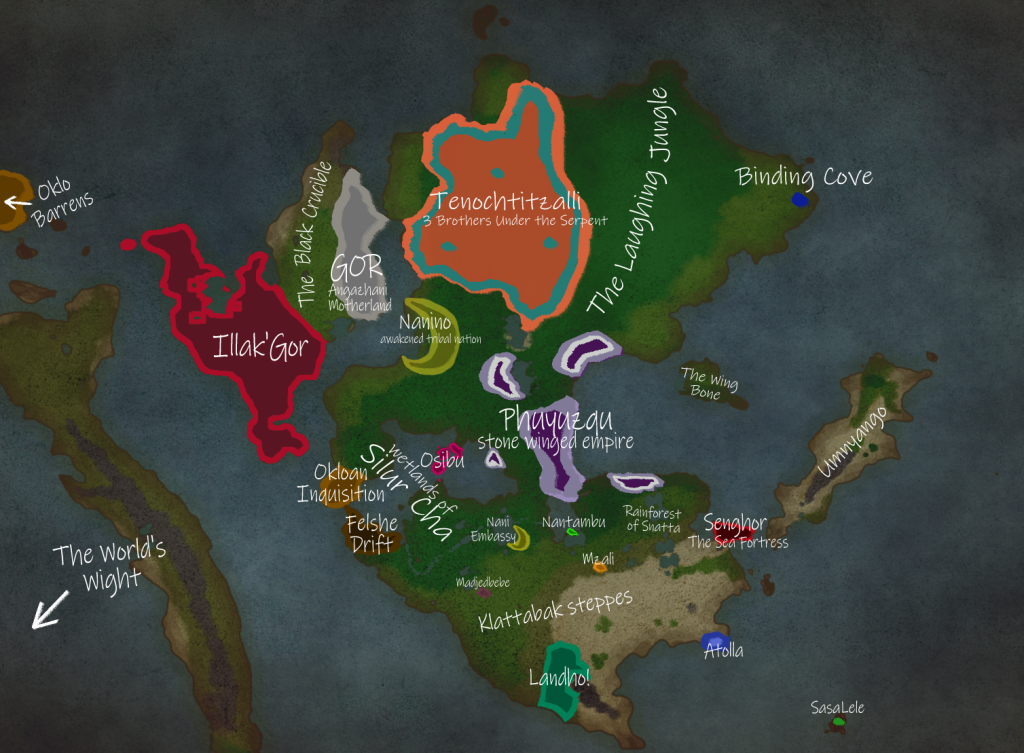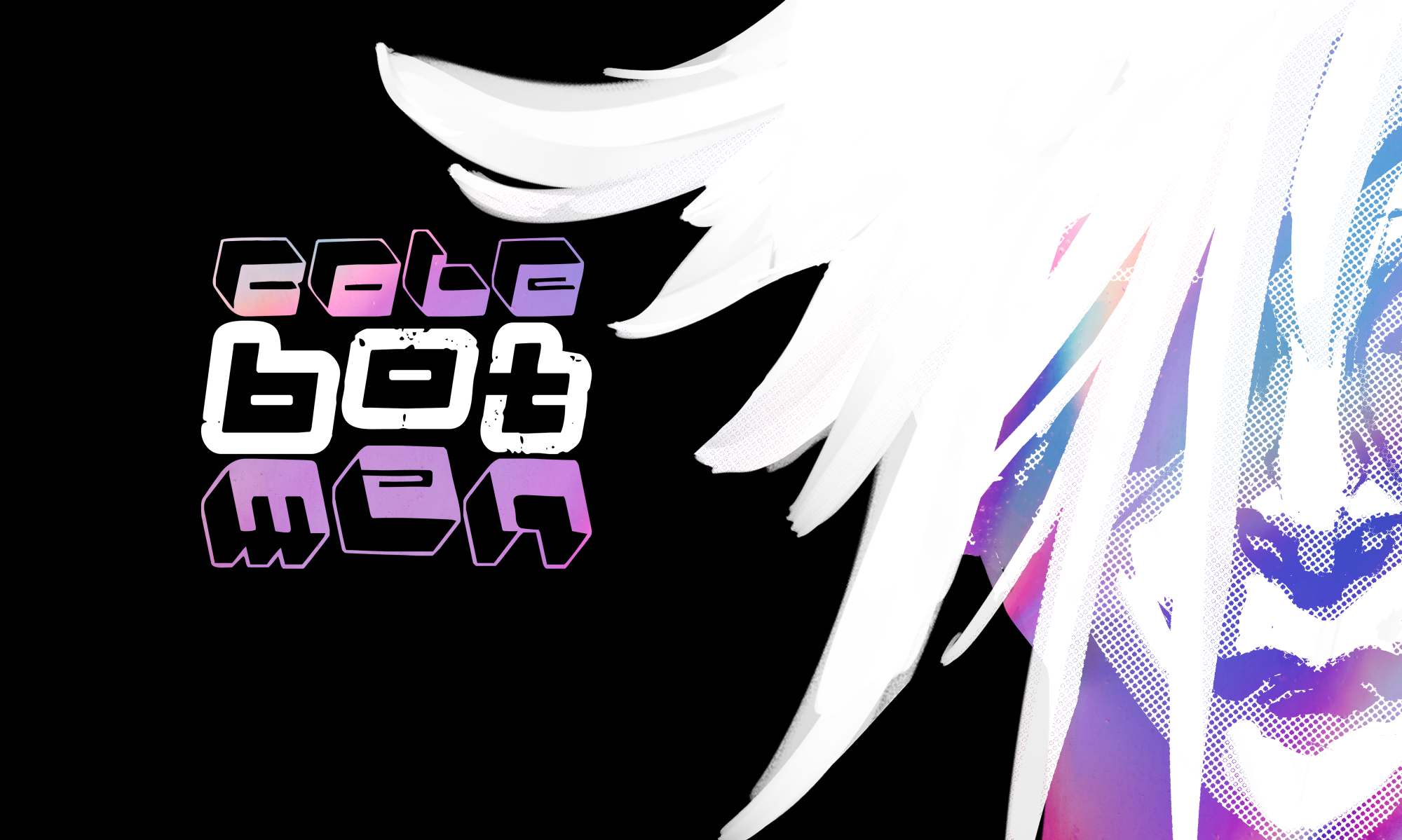Most Recent – Akh in the Shell (Khoursara)
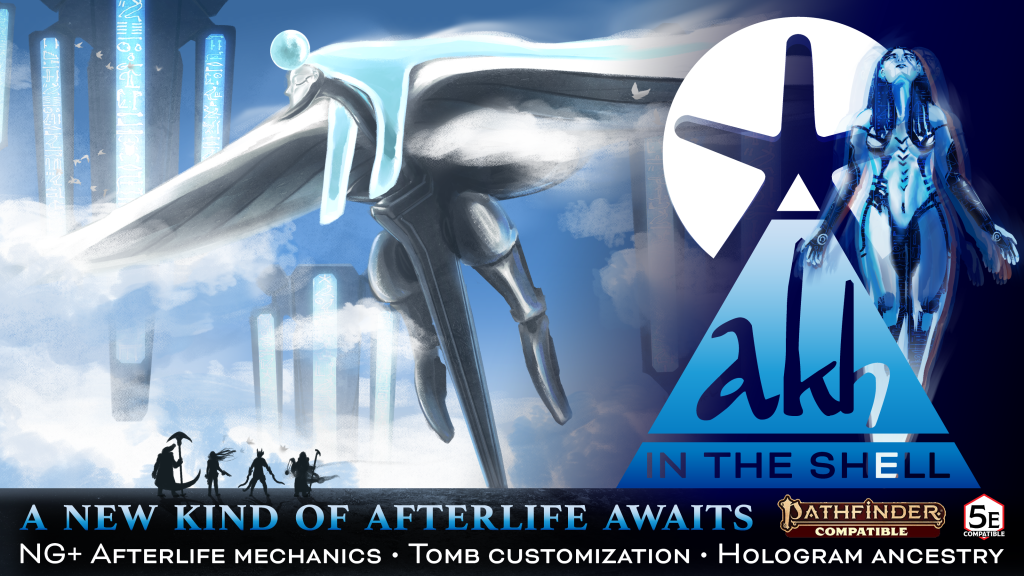
Akh in the Shell is a modular set of rules for integrating the Egyptian Afterlife into your D&D 5e / PF2e game, with optional rules for a Ghost in the Shell inspired science/fantasy holographic technological twist. I wrote, designed, and illustrated the whole thing, with some help from my partner. This is the first section we are crowdfunding for our D&D setting book, Khoursara, City of Seven. Akh in the Shell acts as the first section, which focuses on the scifi-fantasy elements of the world setting.
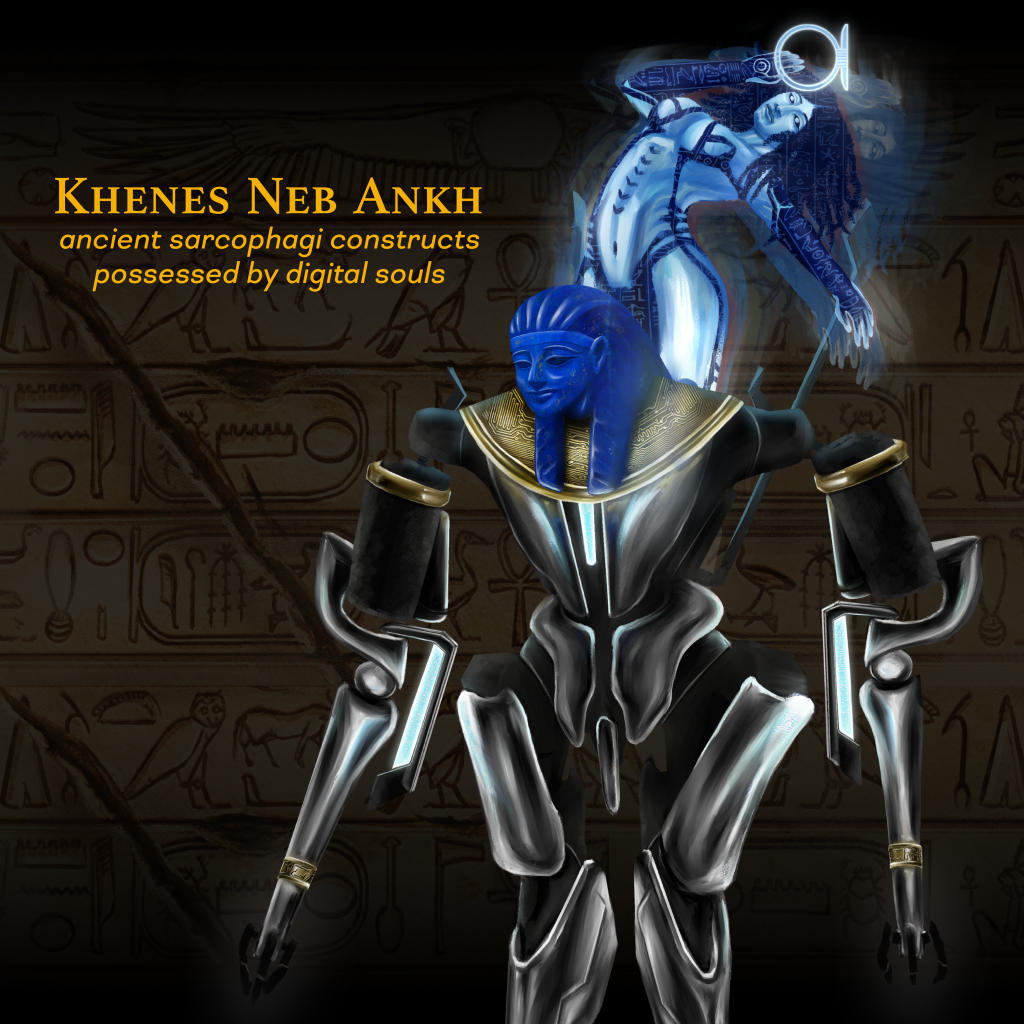
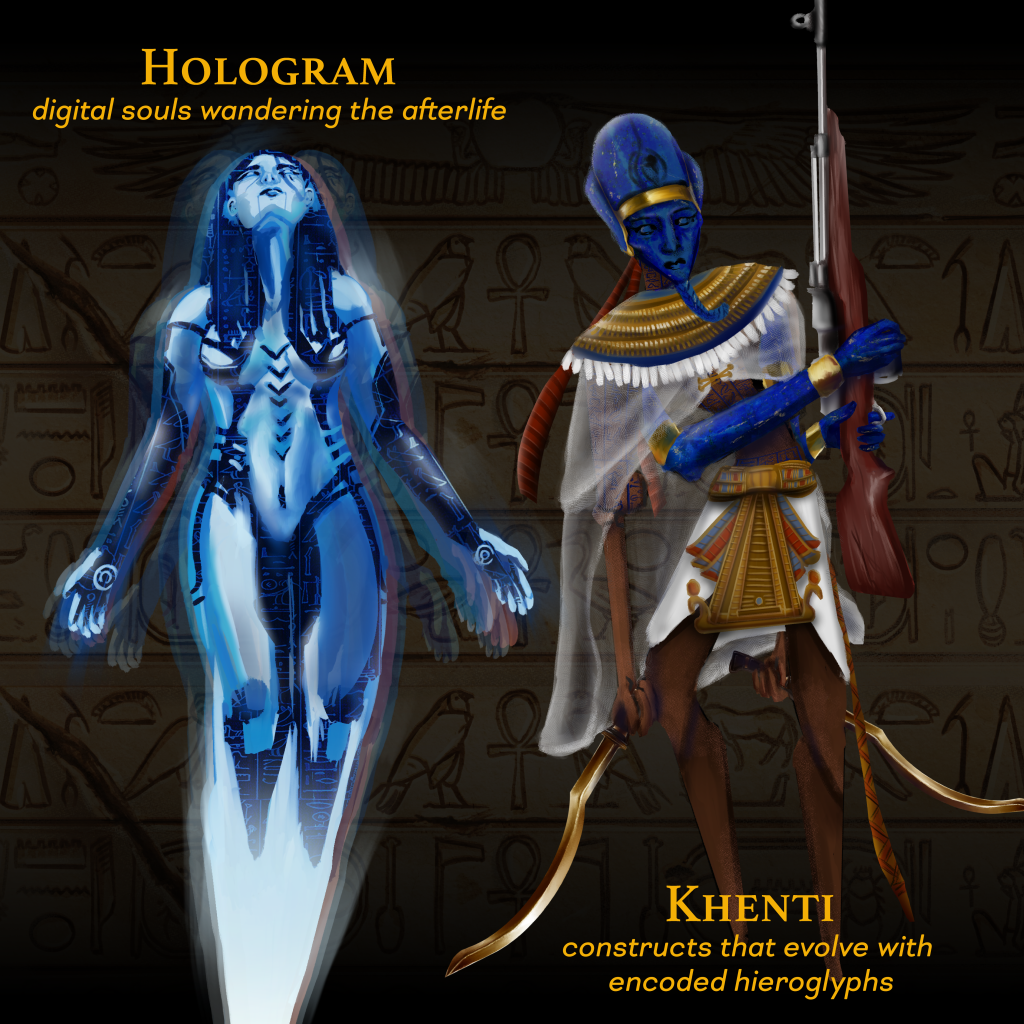
Inside, there are new playable ancestries for your D&D 5e / PF2e game: Khenes Neb Ankh (mechanical sarcophagus constructs possessed by digital souls), Holograms (digital souls), evolving constructs (khenti), and more playable ancestries inspired by Egyptian gods.
A new starter adventure awaits across the great deshrets of Hakibad and beyond! Escort the Pharaoh’s mysterious Chief Lector Priest across deserts of red, gold, and black, towards the megalopolis city of Khoursara where civil conflict among the Noble houses is about to break out.
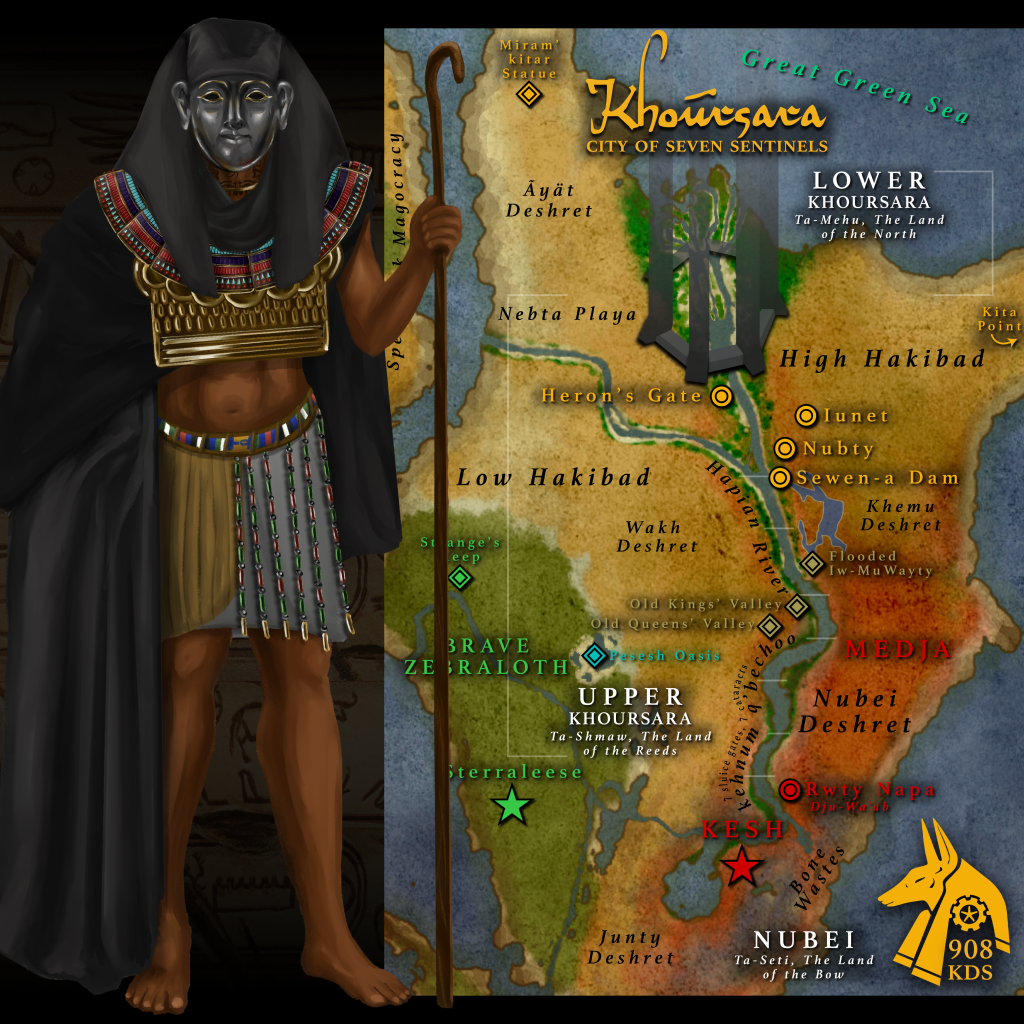
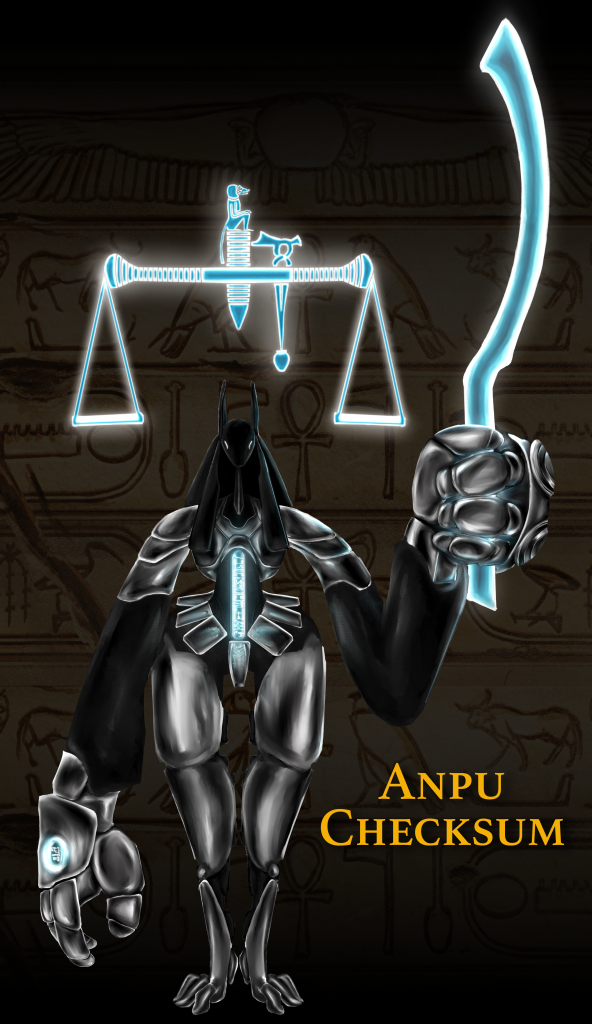
Within the Sentinels are derelict divine machines upholding the very code base of the Afterlife itself from the outside. These mechanical monitors perform a range of tasks, from basic terminal operation to vital soul-weighing ceremonies of the recently deceased for the continuation of the digitizing Afterlife.
Anpu Checksum, Canopic Guardians, Ibis Monitors, and more feature in this book as fearsome mechanical / holographic creatures for your party of heroes to take on in the Digital Duat!
Khoursara: The City of Seven Sentinels
Each section of the Khoursara book (like Akh in the Shell) will exist as standalone pieces that you can get each on their own in PDF format, and eventually they will be combined into a full setting book (see below)!
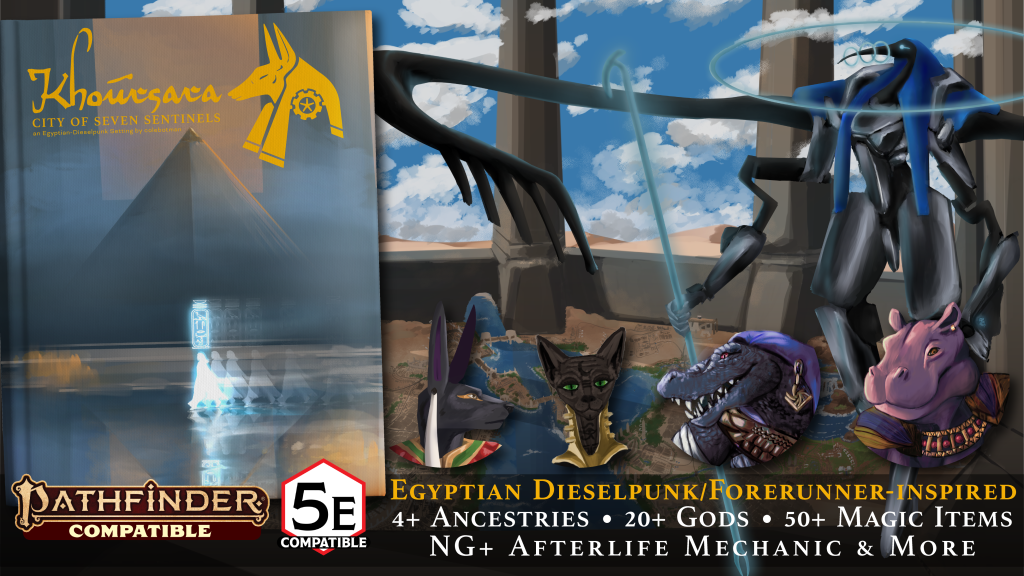

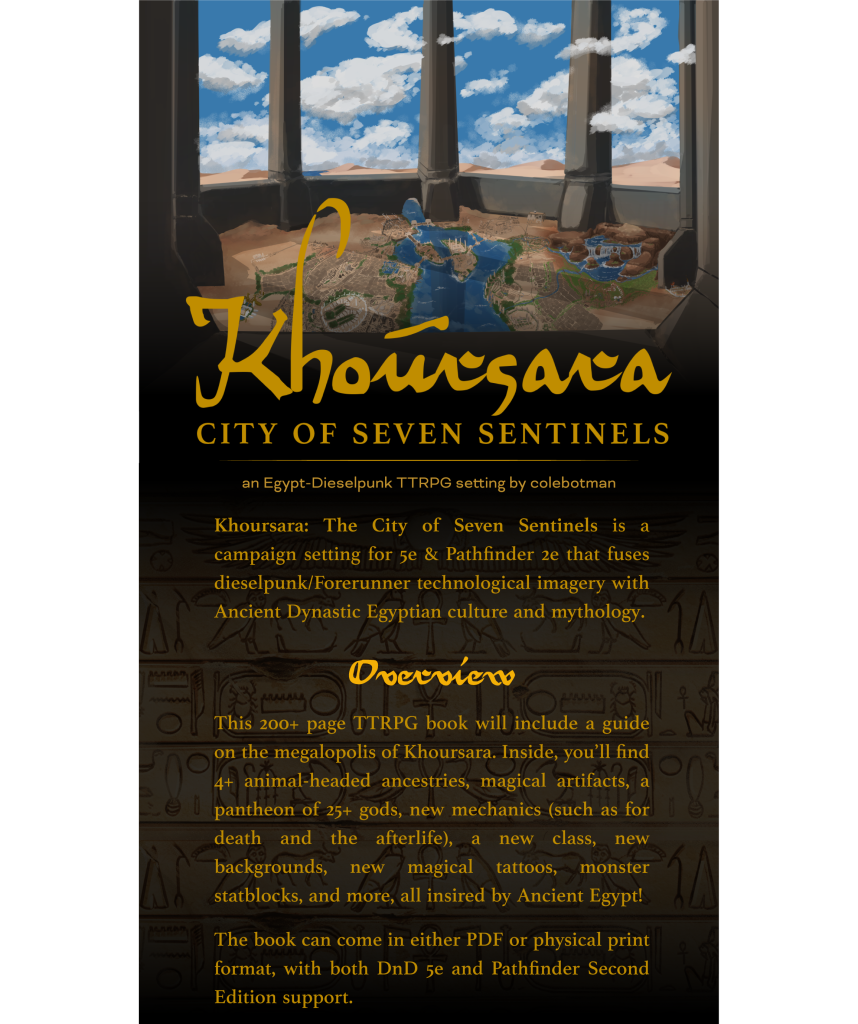

Using Kickstarter, I want to publish a D&D TTRPG setting book that allows players to interact with the high-fantasy dieselpunk megacity I’ve written, inspired by ancient Egyptian mythology and Halo / Ghost in the Shell imagery. The writing and game design derive from the art history courses taken over the length of my college career, which influenced me to read even more on cultural inspirations for game mechanics. I wanted to blend the pantheon, afterlife, and cultural traditions of the Predynastic, Old, and New Kingdoms of ancient Egypt with present-day Egyptian-Arabic speaking Cairo. I applied this not only to the setting and story of the world, but in the design of the book’s layout as well, such as in this style guide that informed the rest of the project.
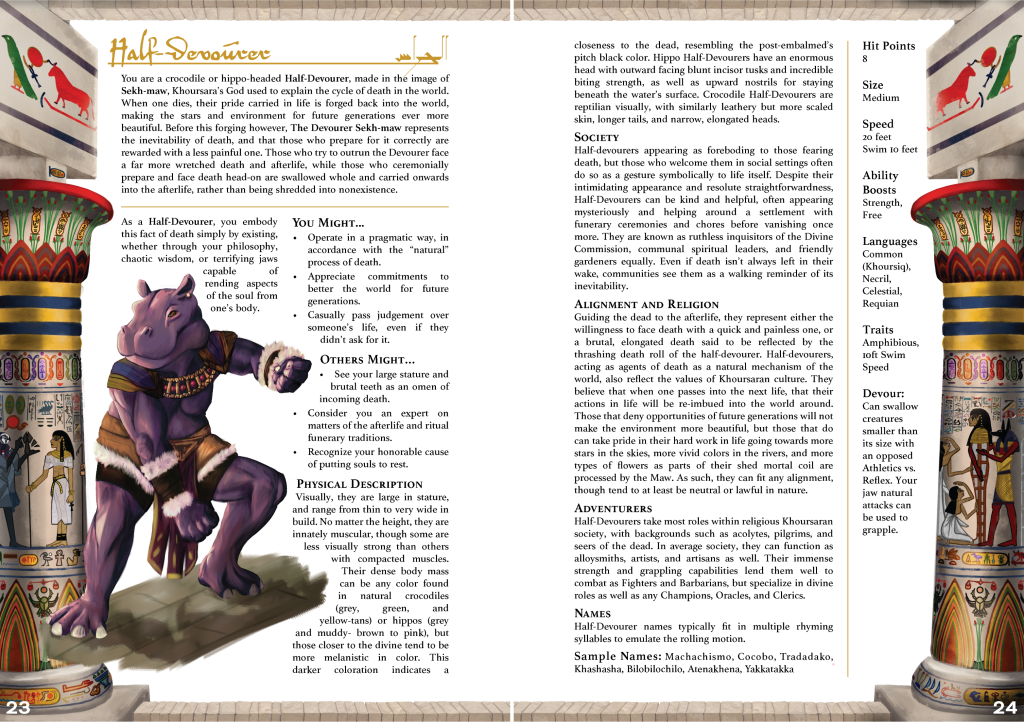
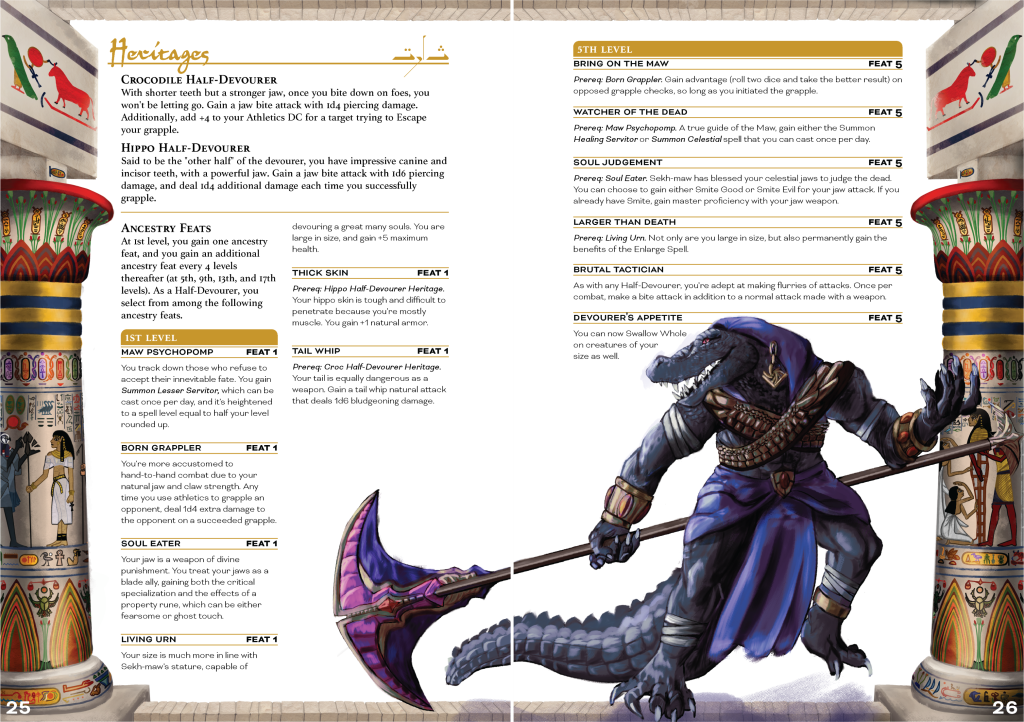
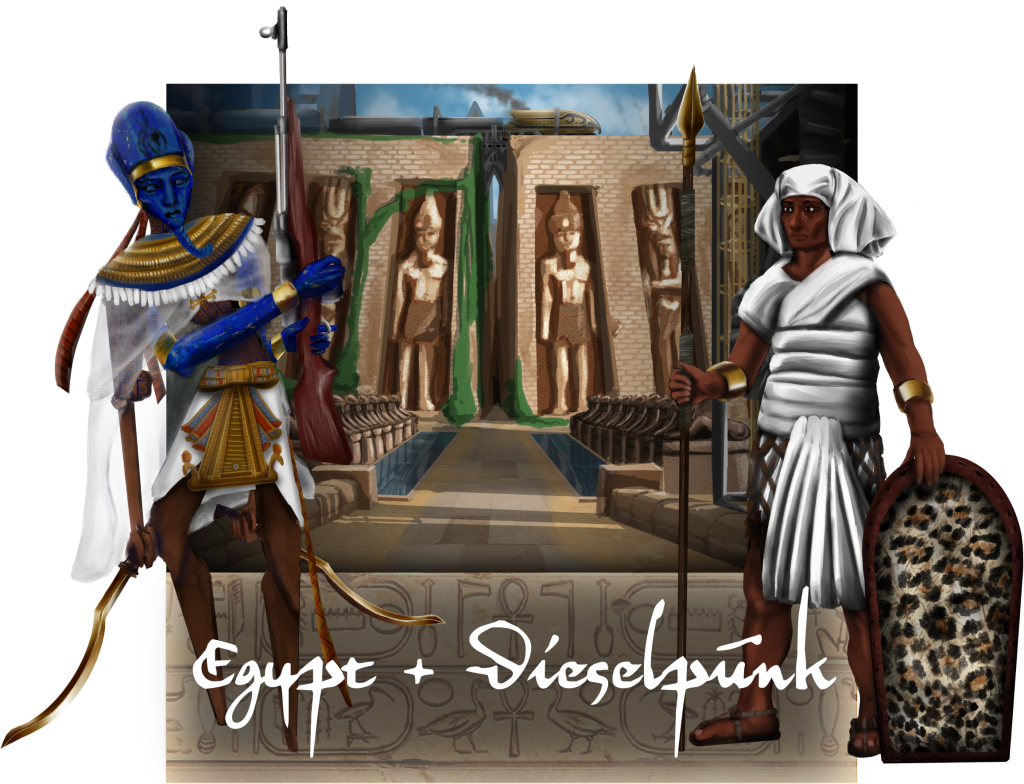
A city within the world of Infinis Ajer, Khoursara, the City of Seven Sentinels is one of the oldest cycling cities in the world. The “Sentinels” are towering spires that climb into the heavens surrounding the city’s walls. The megalopolis city is made up of numerous districts, each the size of New York city. As of 908 KDS (Kynd Set Date), Pharaoh Pyrrhic Adaephonus rules over Khoursara, and his 7 Nobles and their houses oversee aspects of day to day life.
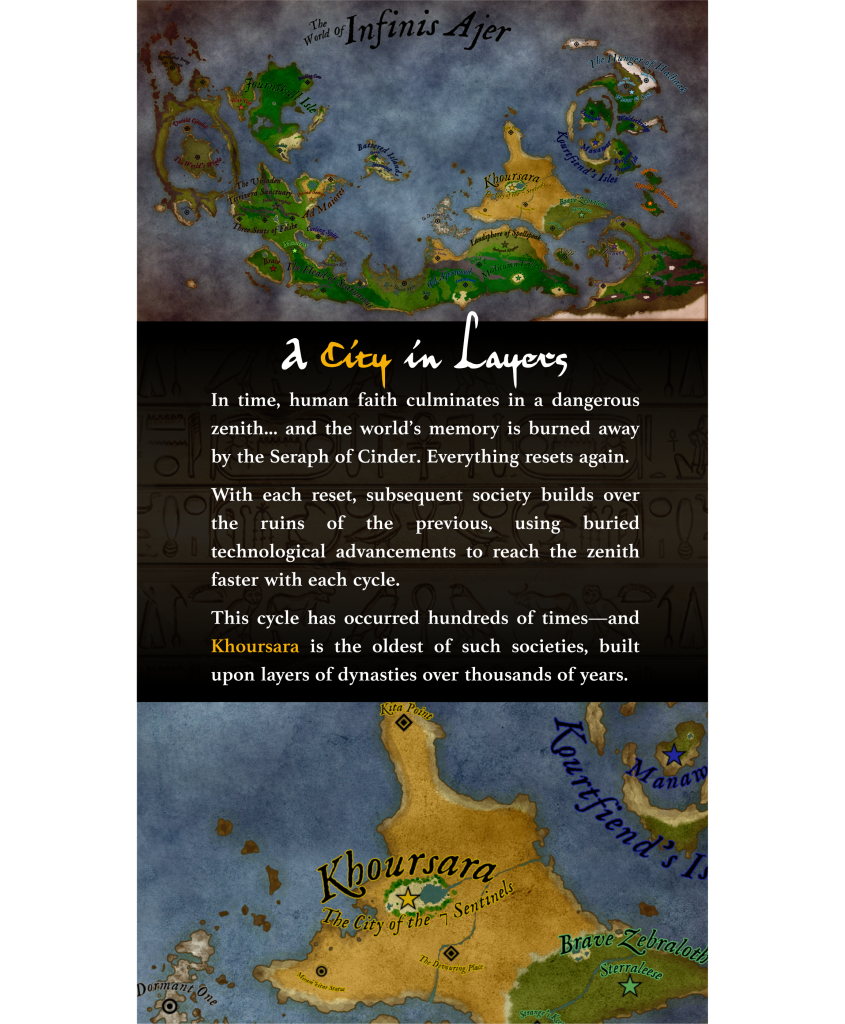
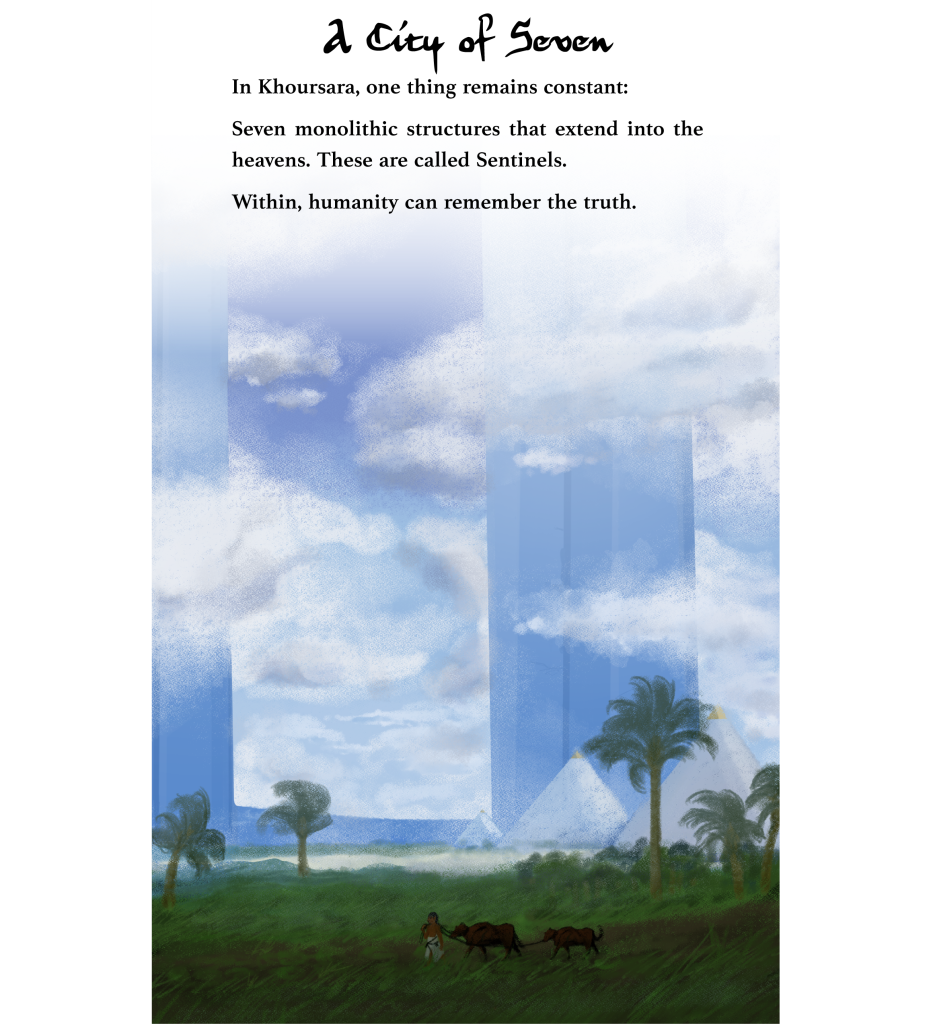

Inside the city of Khoursara, you can play / meet many different ancestries and creatures, all of which are meant to reflect the Egypt-inspired animal-headed gods. A core part of the book will focus on these new ancestries, with numerous suitably divine thematic feats for each, influenced by the Gods of the setting itself.
For instance, Half-devourers are crocodile and hippo-headed humanoids that trace themselves back to the Goddess, Sekh-maw the Great Devourer. They’re able to rend the Ka (the aspect of the soul that makes us alive) from the body of those judged as unworthy. Hairless sphynx cat Mirankh embody a Goddess who was split into two parts, her eyes of truth and her body of knowledge – Miram and Kita. They tattoo their life stories onto themselves, carrying on and becoming empowered by their family’s traditions and tales. There are many more playable ancestries planned for the full book, such as jackal-headed Jackhasans, snake-headed Oserpenti, and more. I commissioned Mingi Webber (@Sinner_Minner) to help me with the Half-devourer and Jackhasan art, making the rest of the book’s art myself.
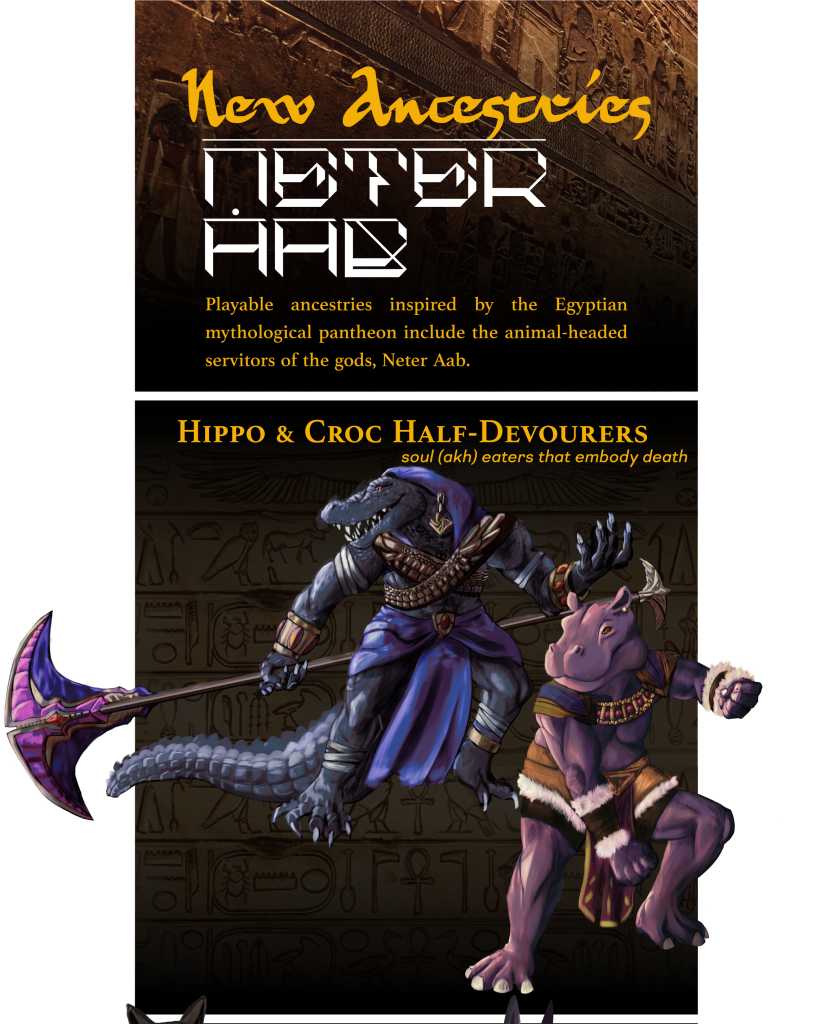
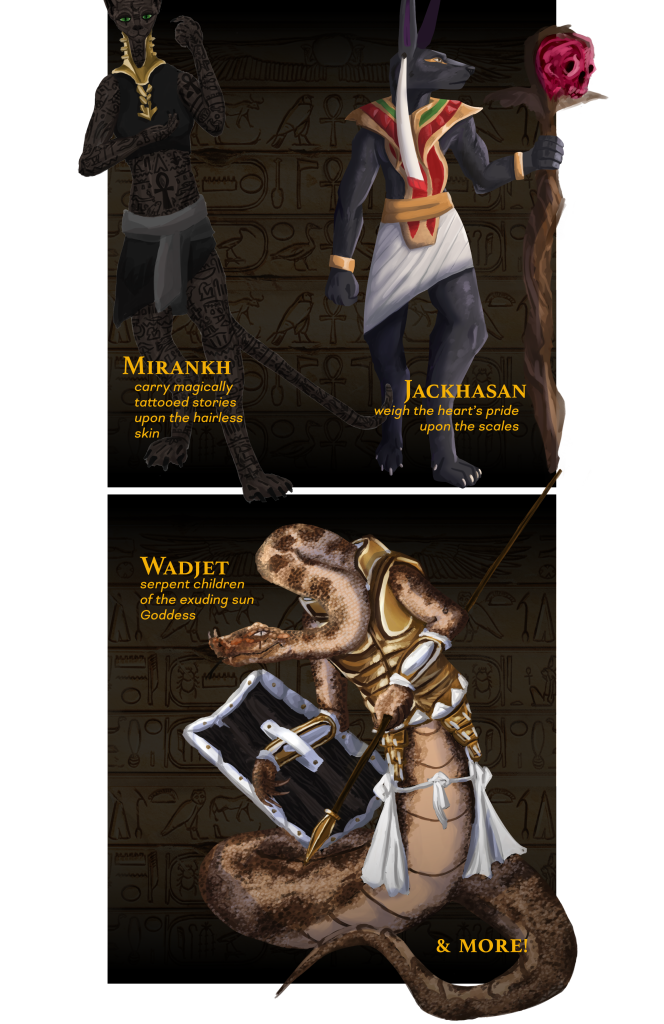
An additional 50 items, illustrated by Mingi Webber (who also drew some monsters and ancestries), will also be included, which you’ll be able to get on cards with their mechanics I designed on the flip side as an optional add-on.
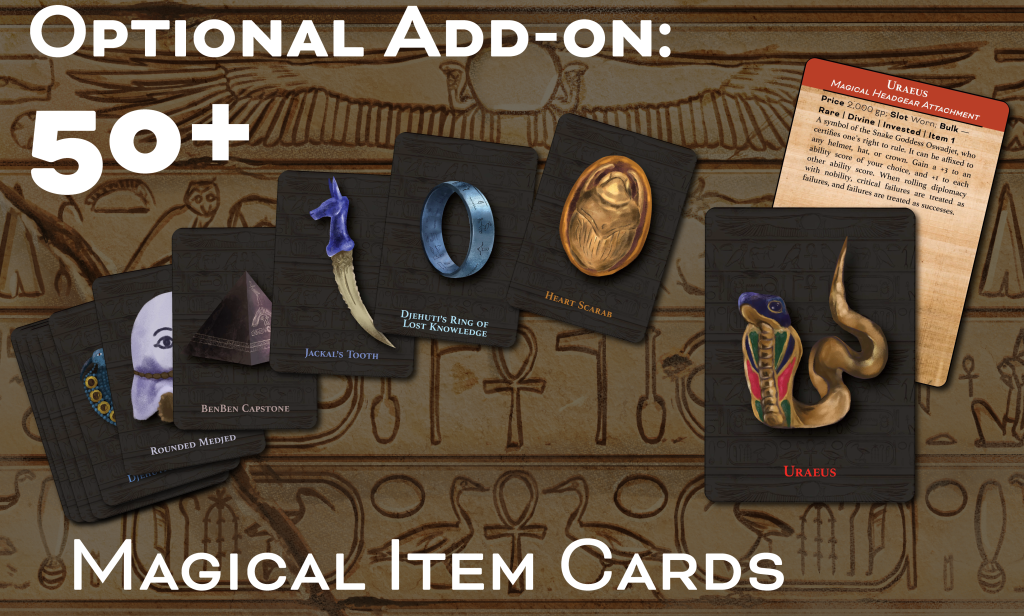
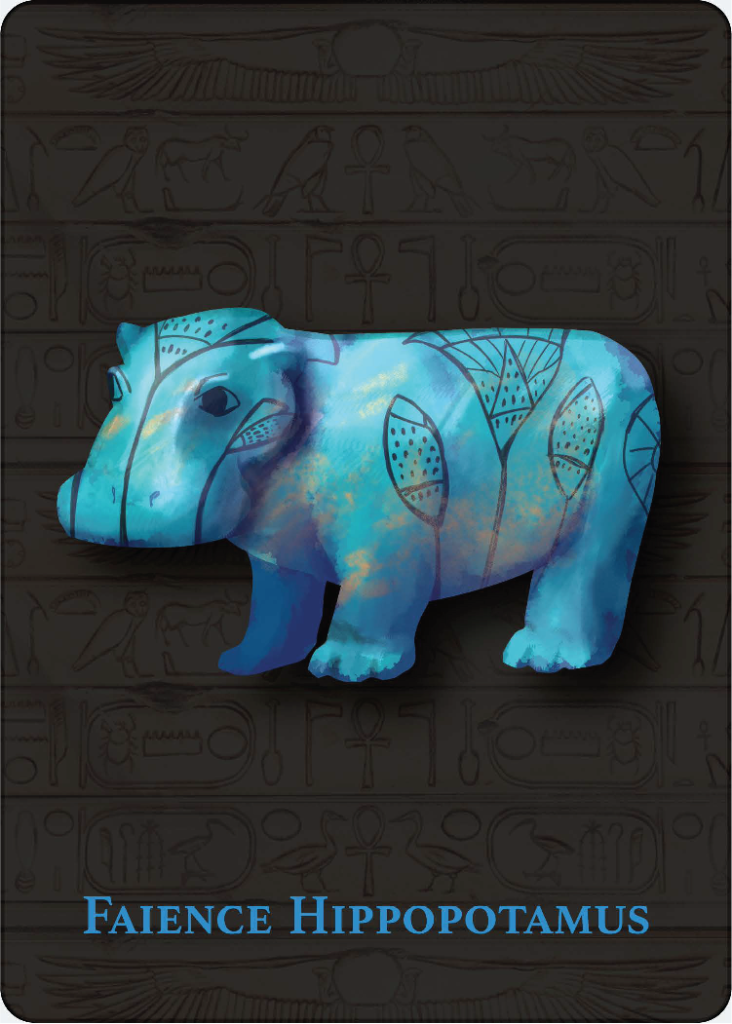
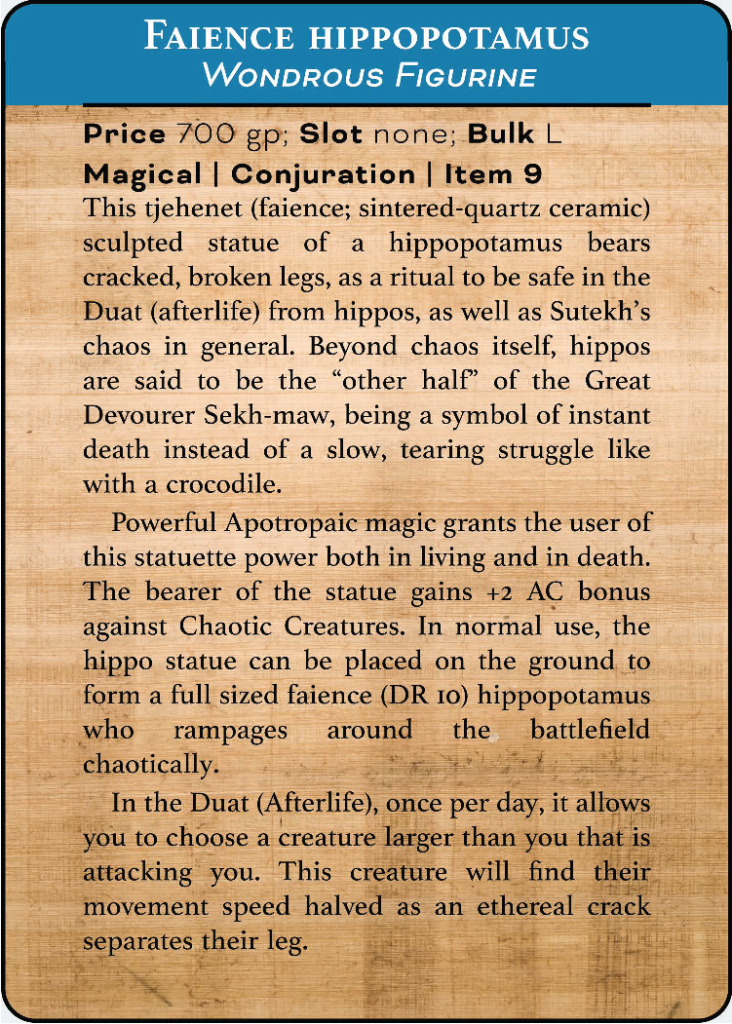
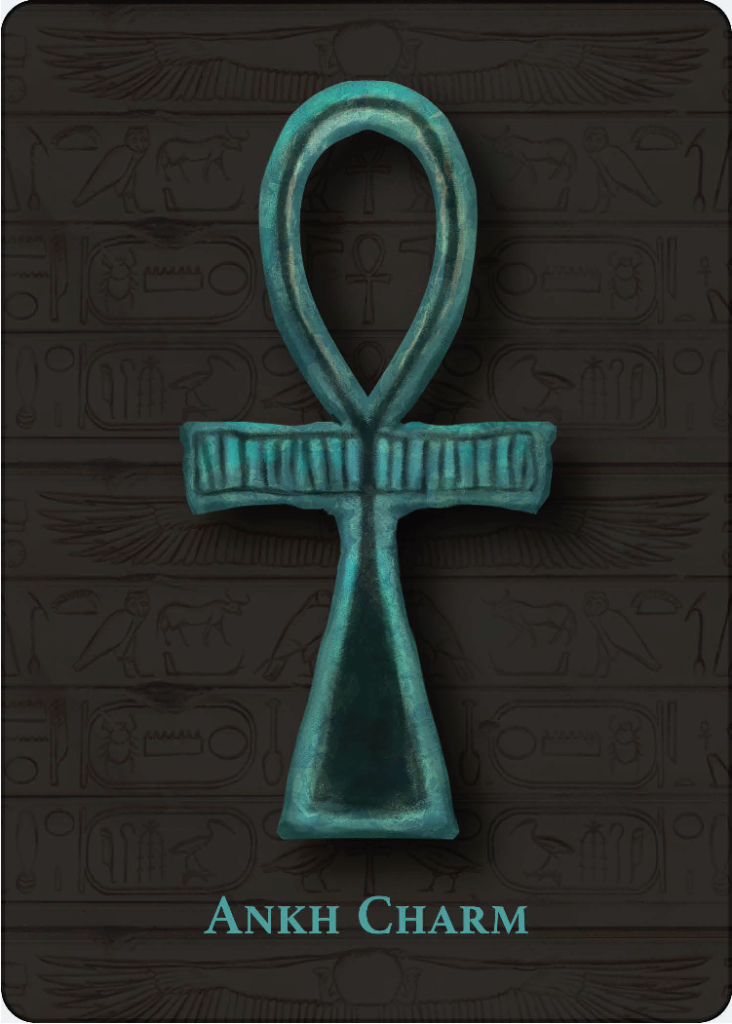
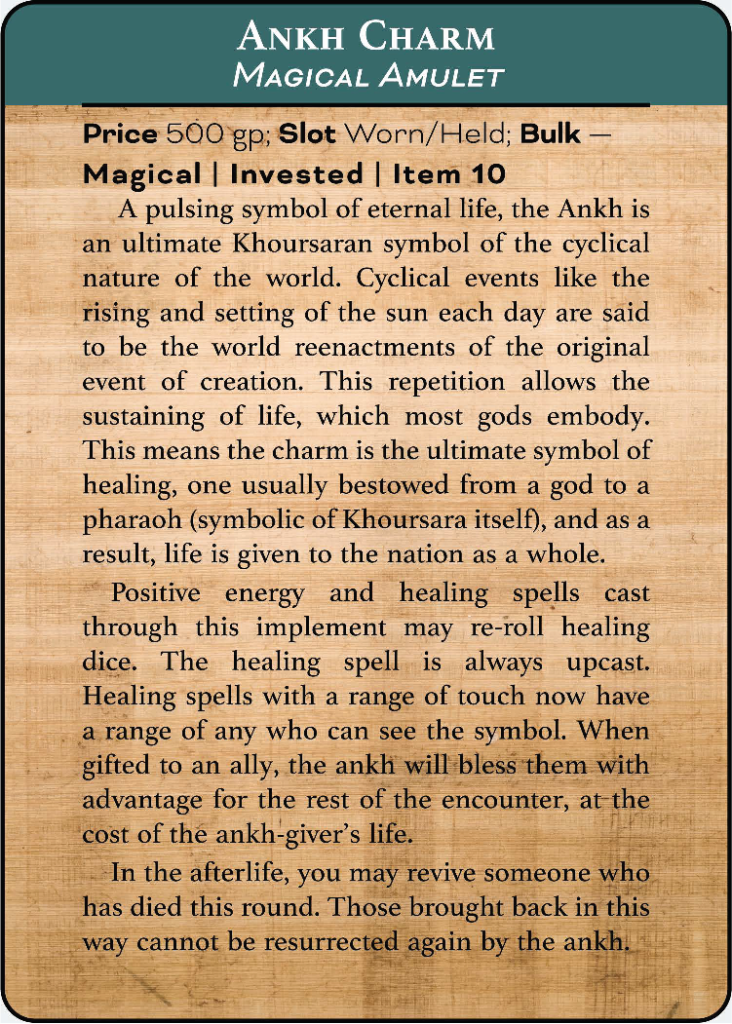
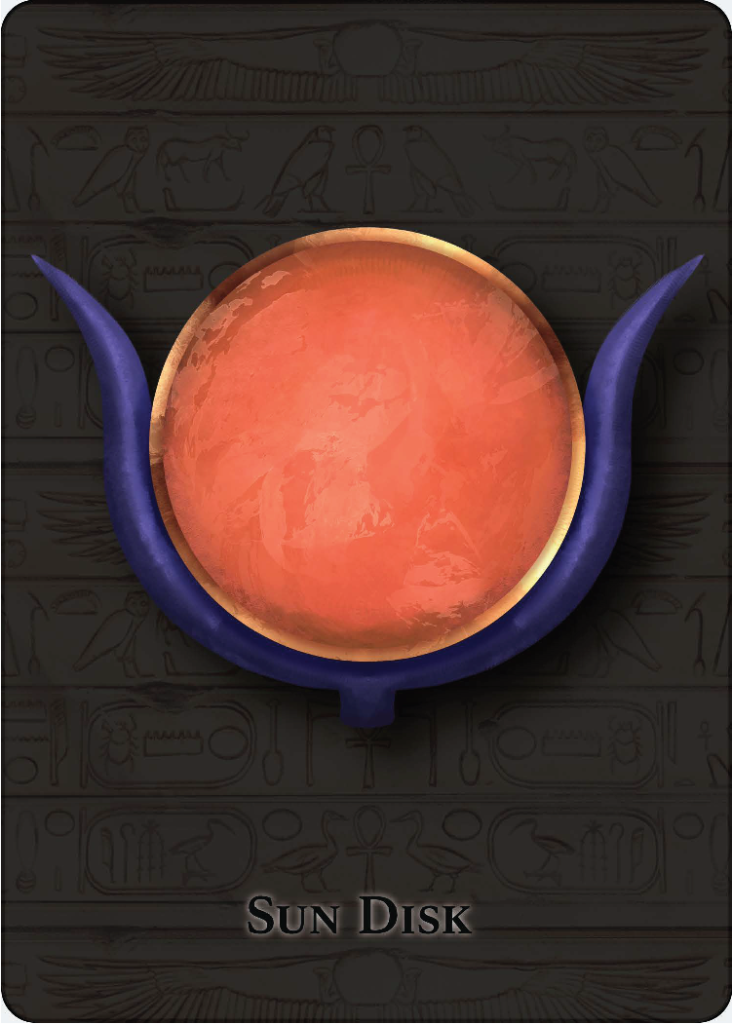
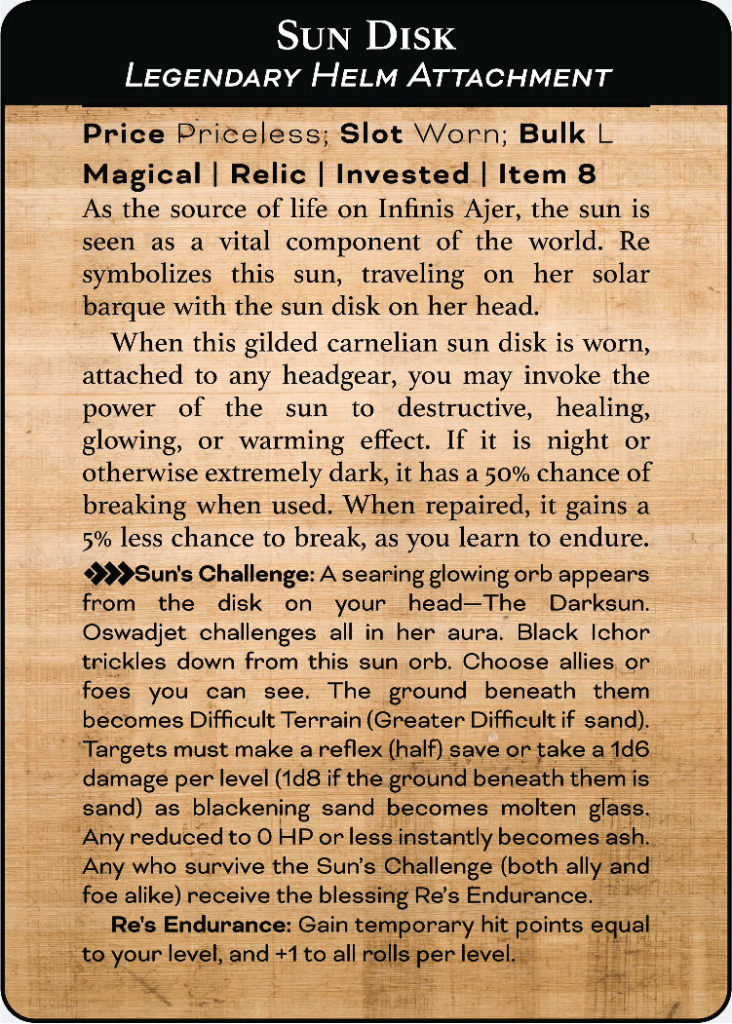
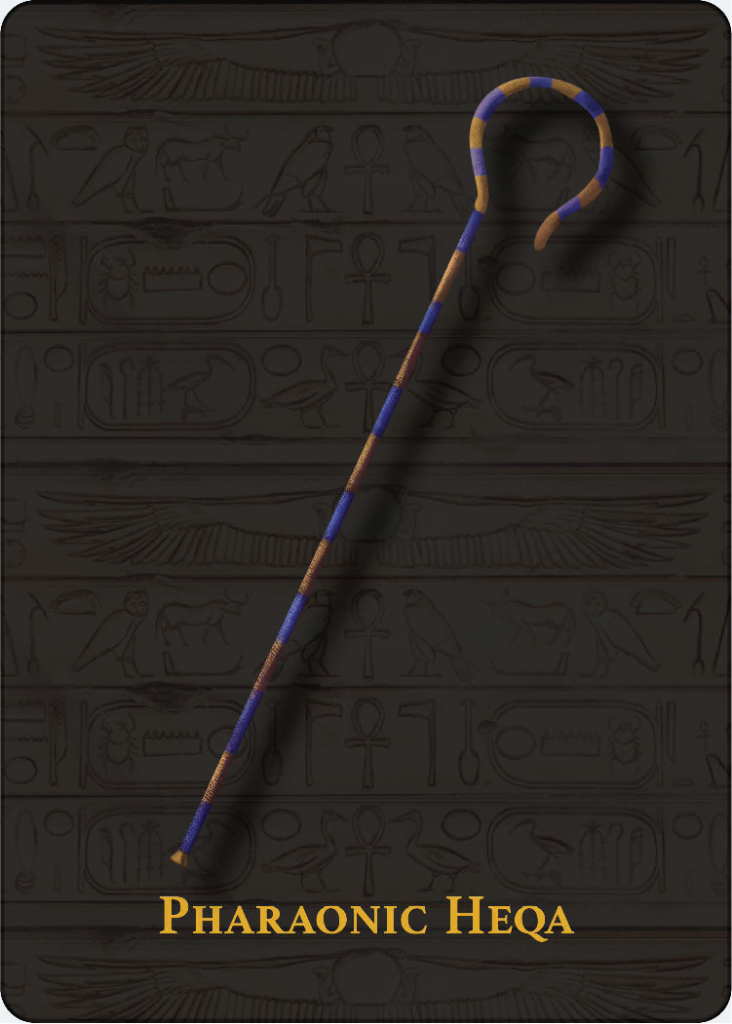
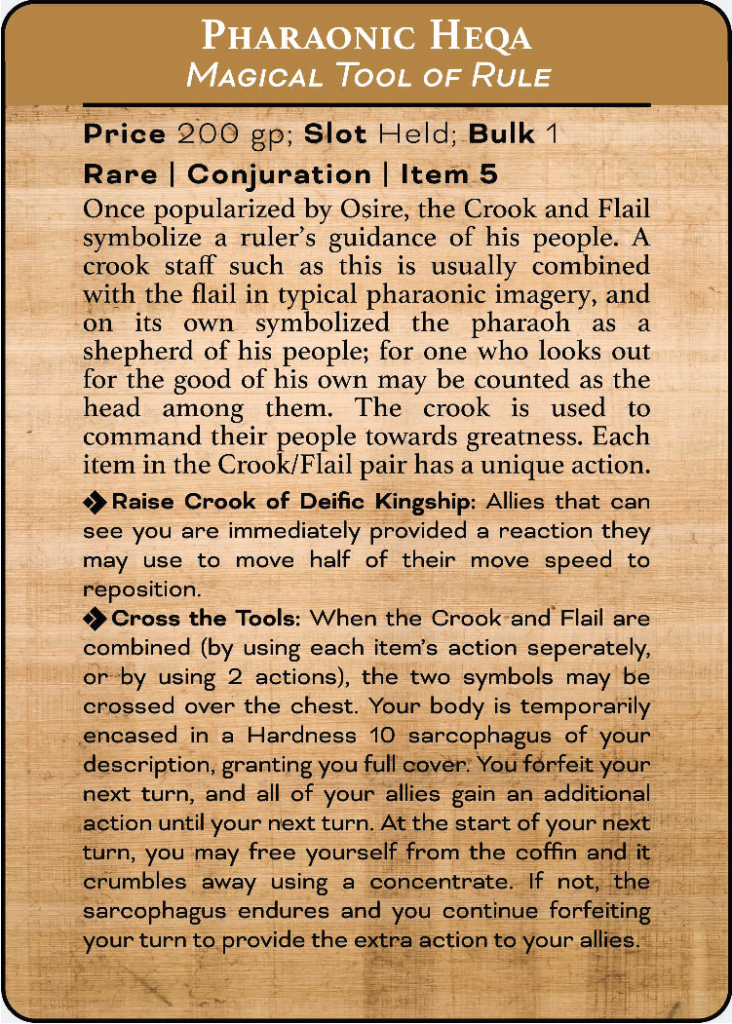
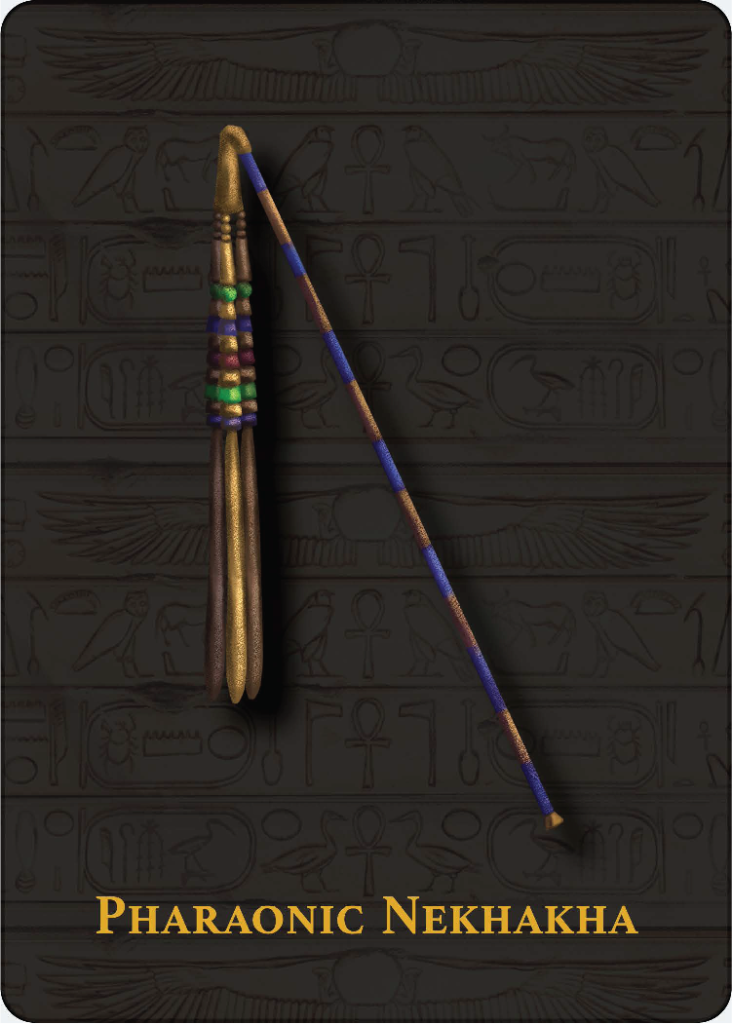
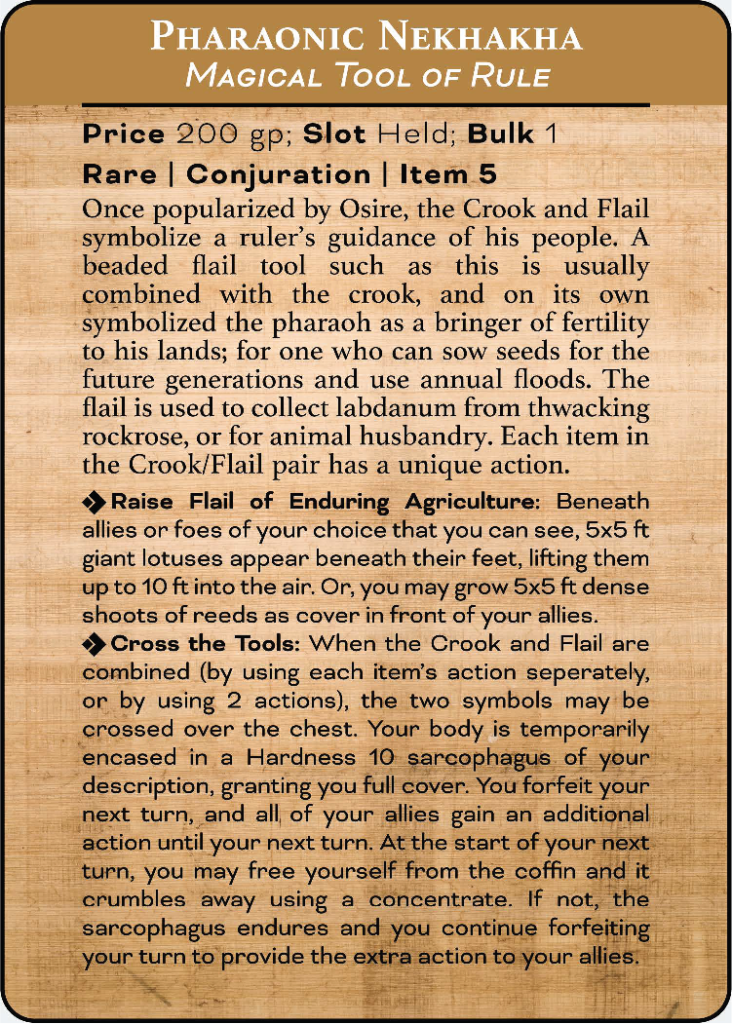
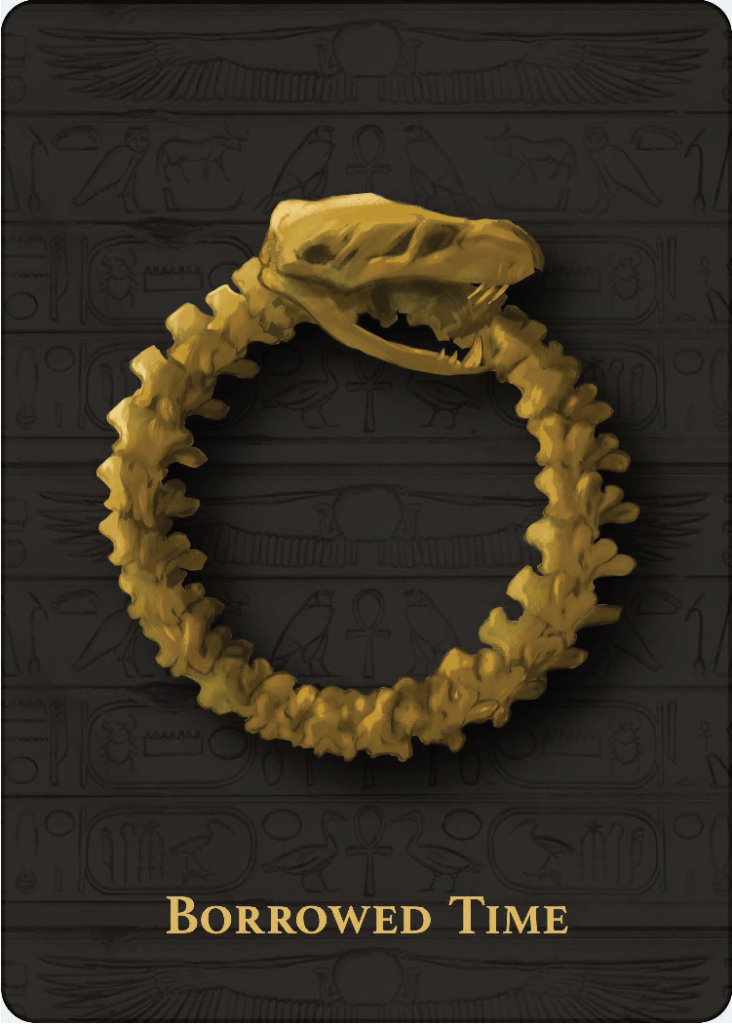
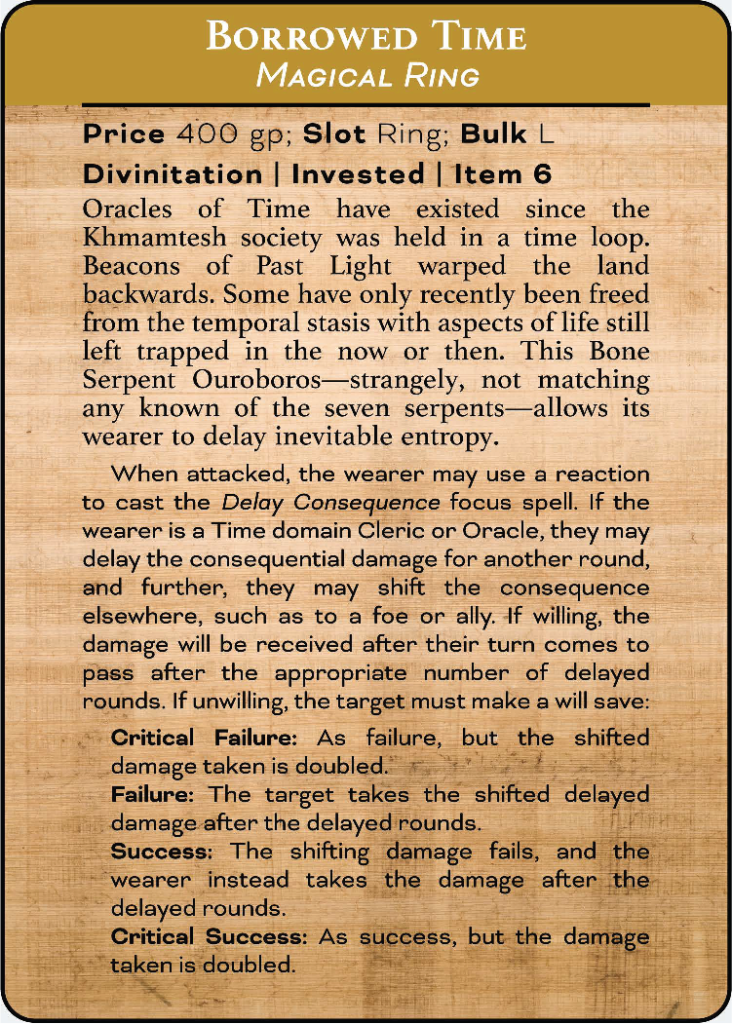
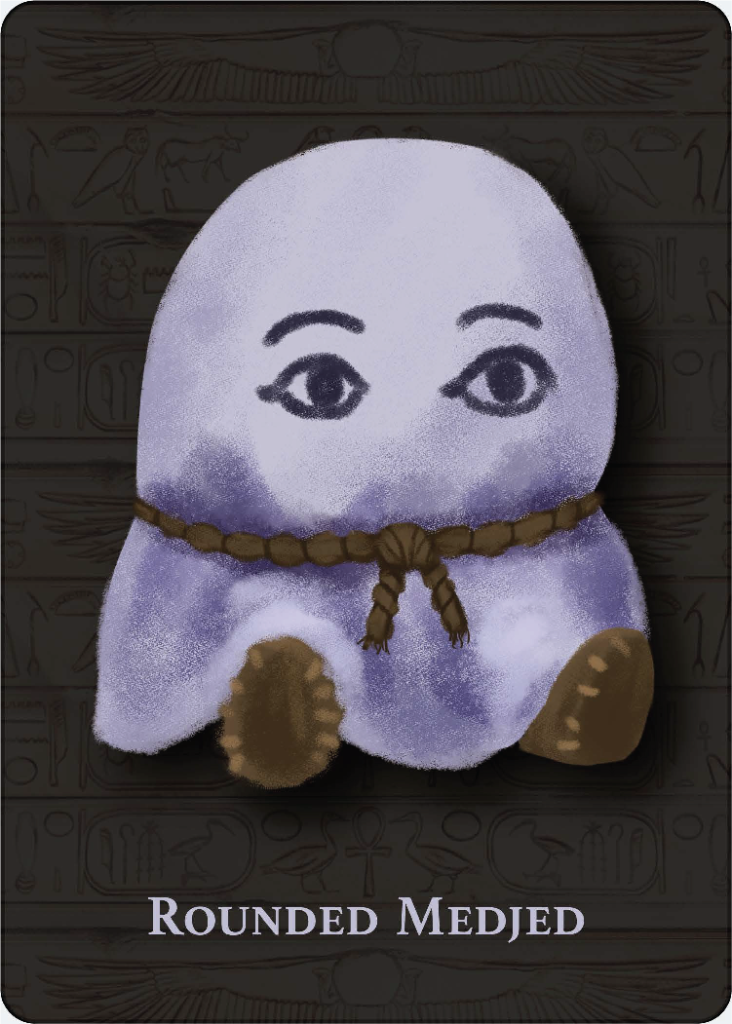
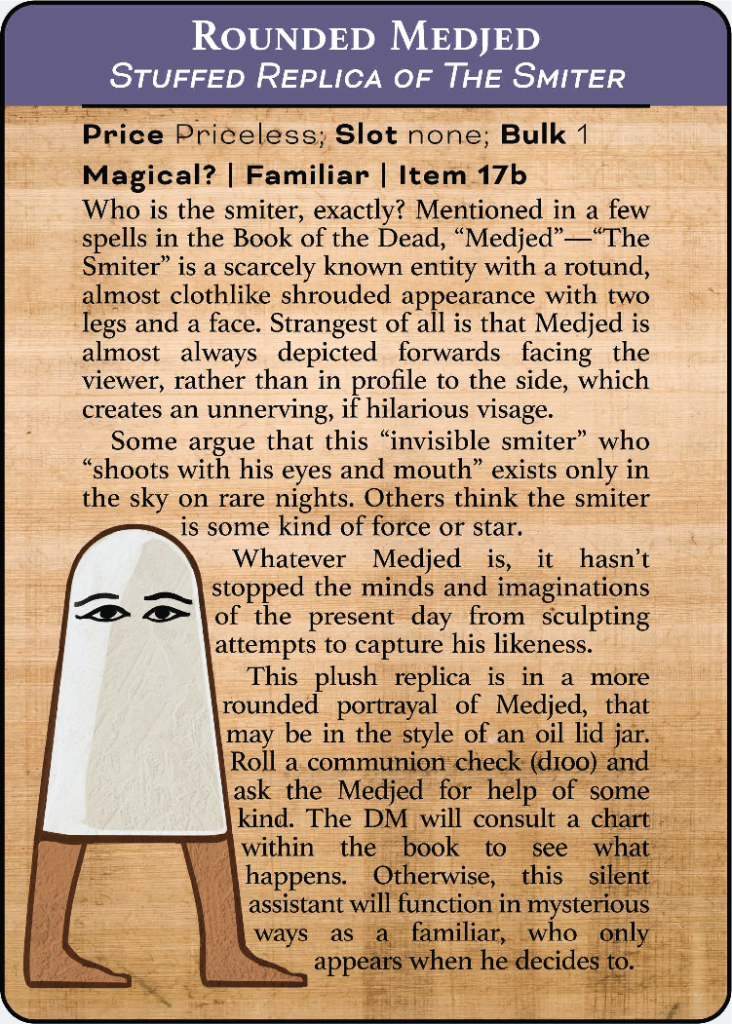
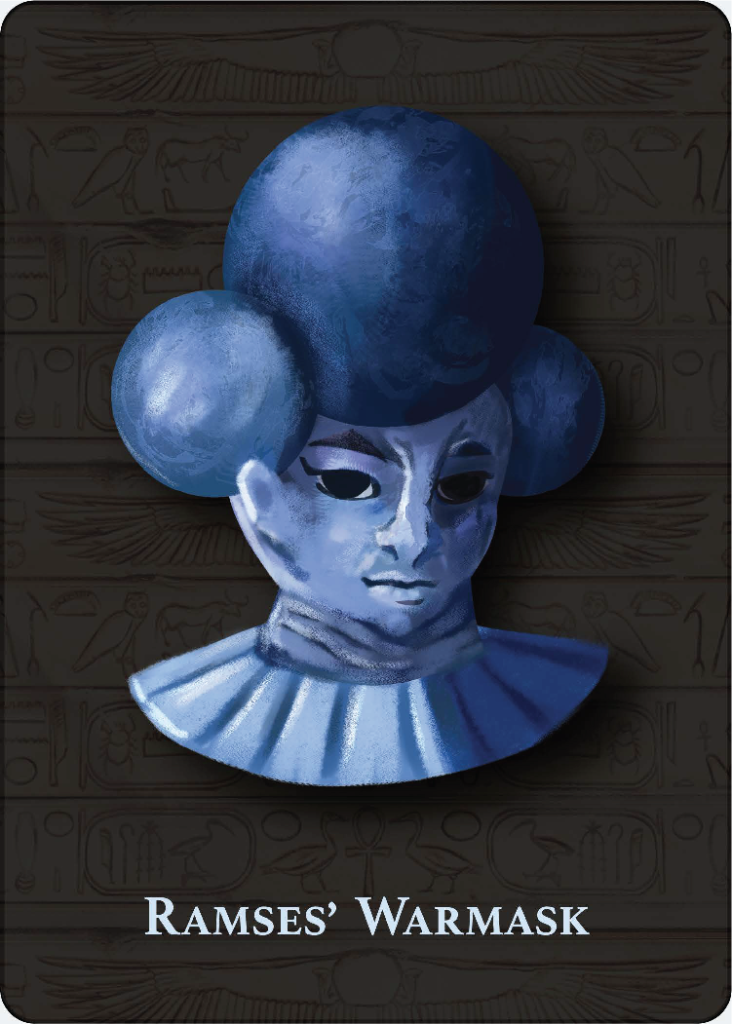
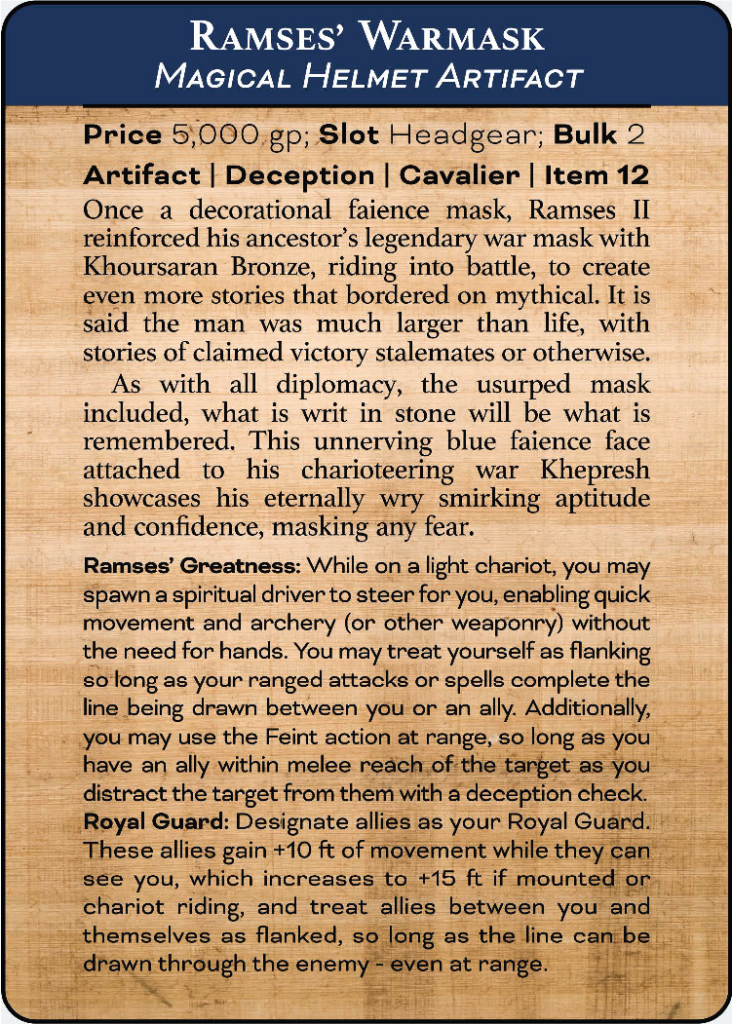
Additional rules in the book will include The Duat (or Afterlife) which will function like a New Game+ that you’d see in video games, where when one dies, preparations made for the afterlife will impact the kind of game you can play in the world afterwards. Optional rulesets lean into the Halo and Ghost in the Shell inspirations more, in that The Duat is becoming digitized, and as such, those who pass into the afterlife have their soul / Akh (and other parts of the perceived Egpyptian soul that make up it) corrupted, distorted, and lost.
This means players can opt to become holographic in nature (with the Hologram archetype), or upload their consciousness into a shell, like with the new Khenti ancestry (shown below with the Shabti heritage).
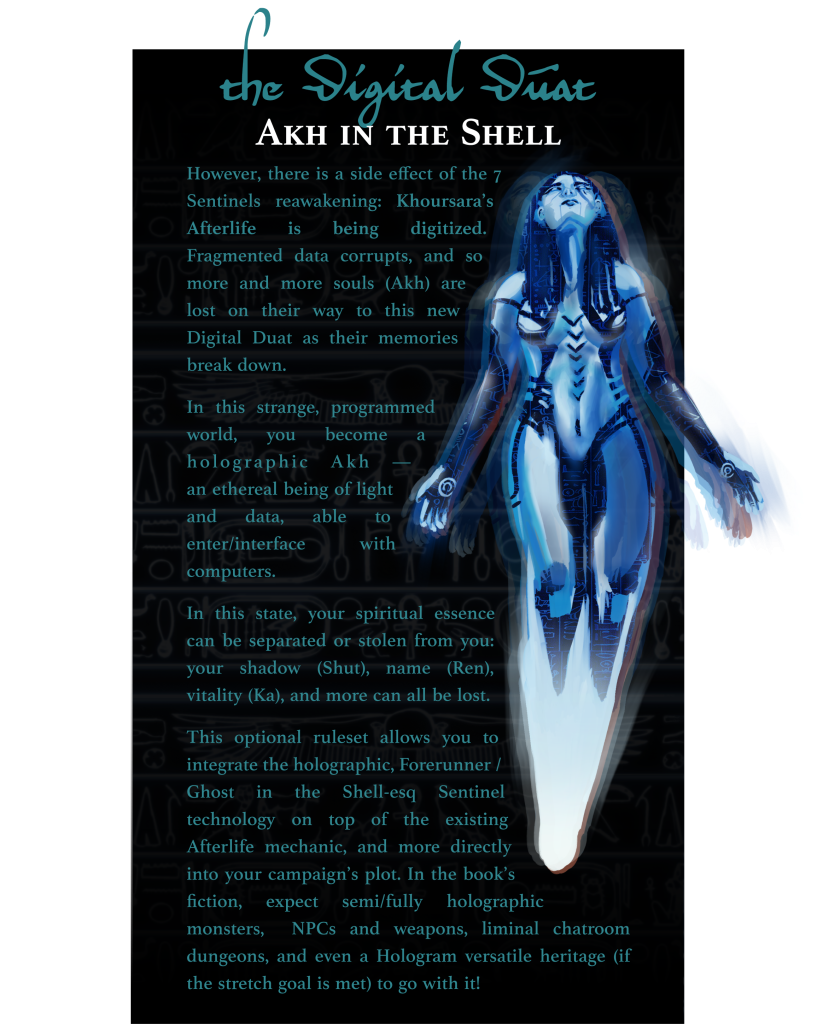
Other mechanics will include a new class – the Farseer, new monsters, new archetypes (such as the aforementioned Hologram), new Cleric / Champion Gods and faiths, and numerous items, all themed around Egyptian mythology and art history.
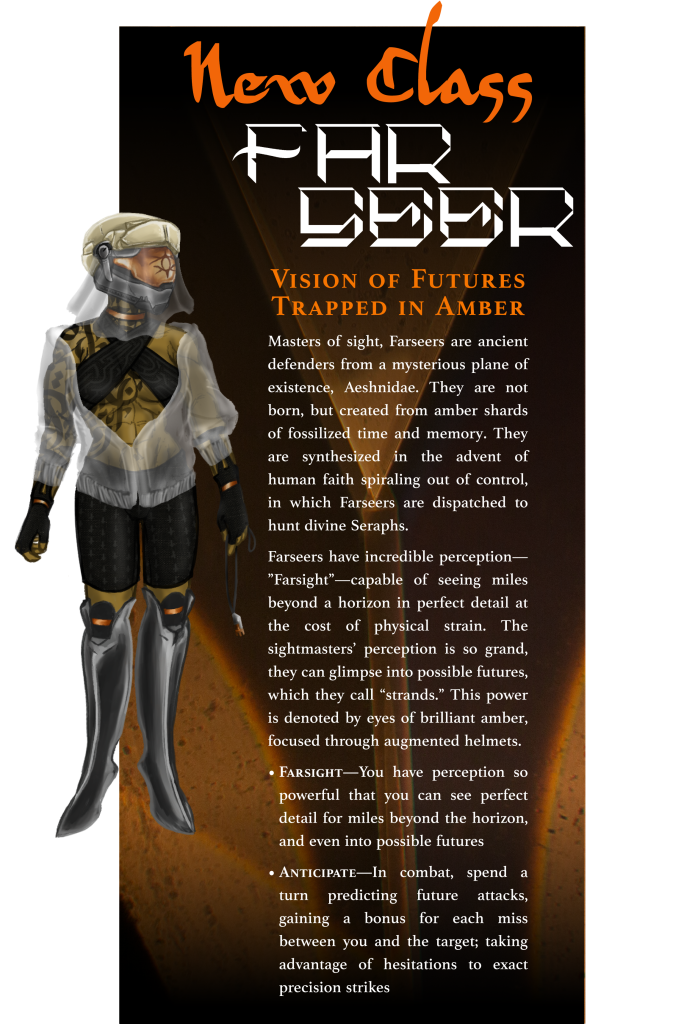
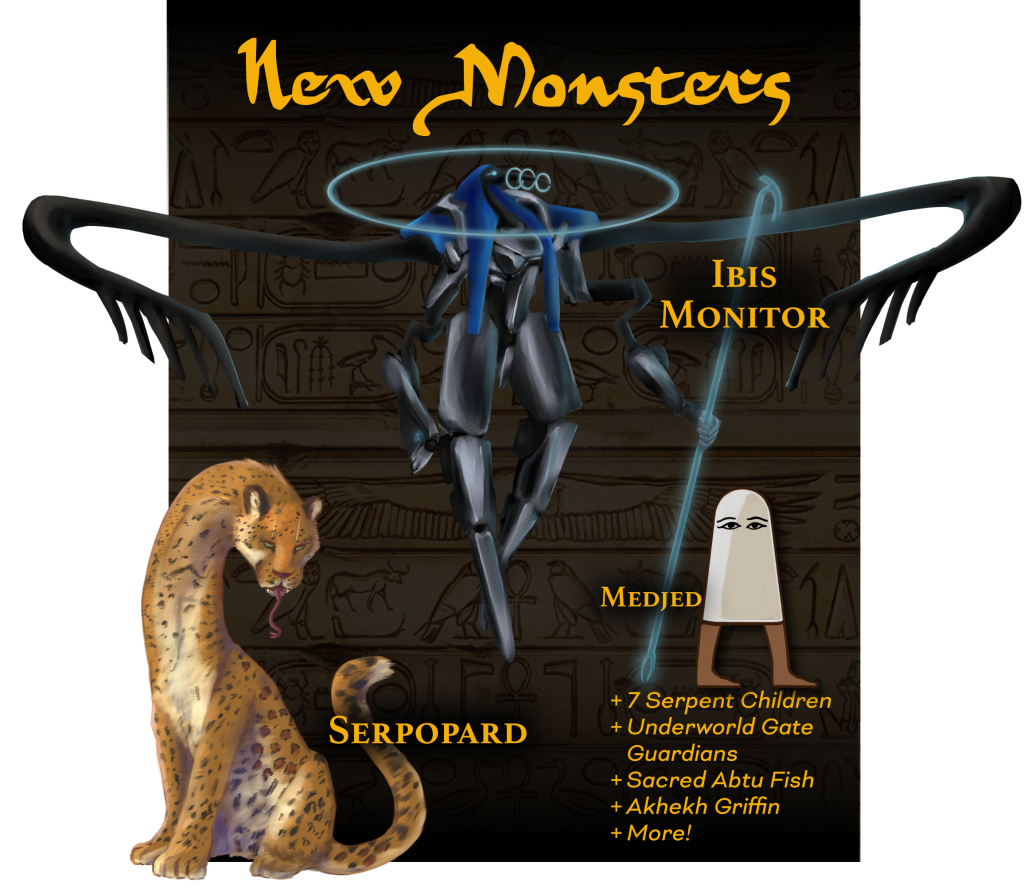
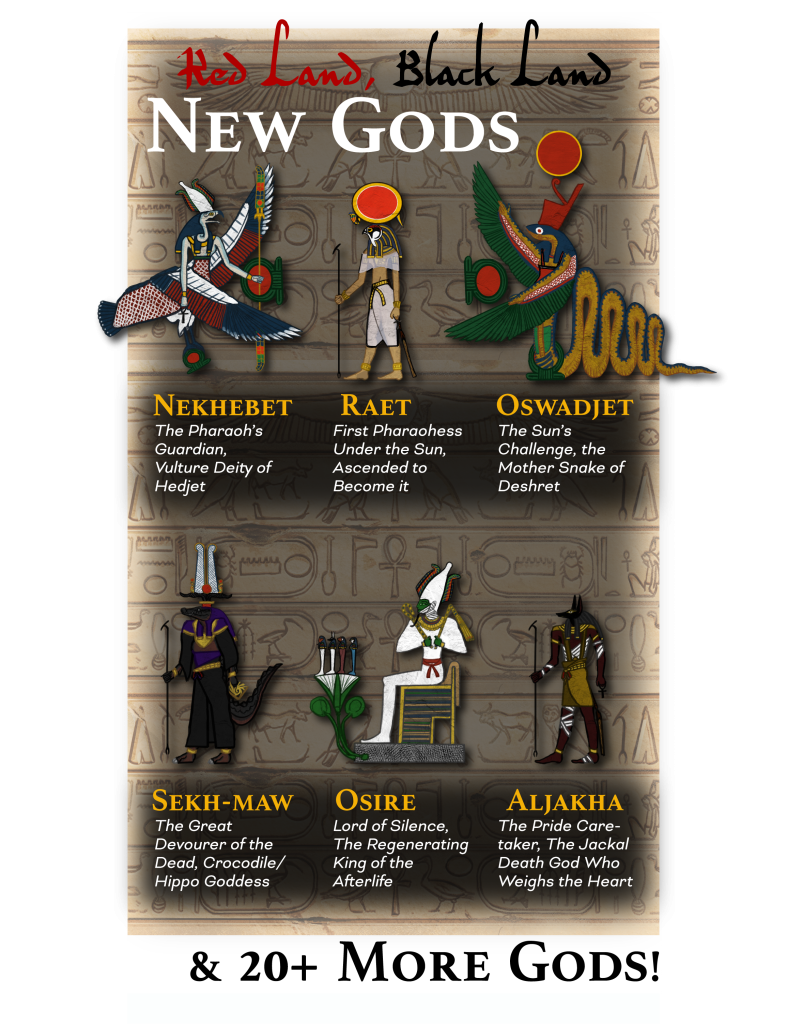
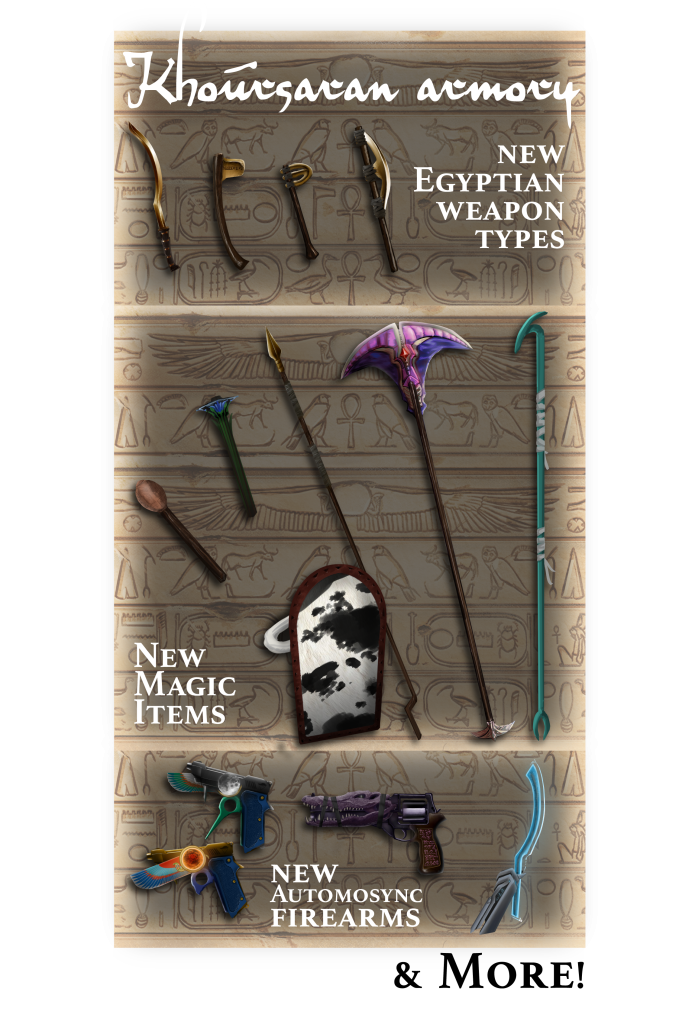
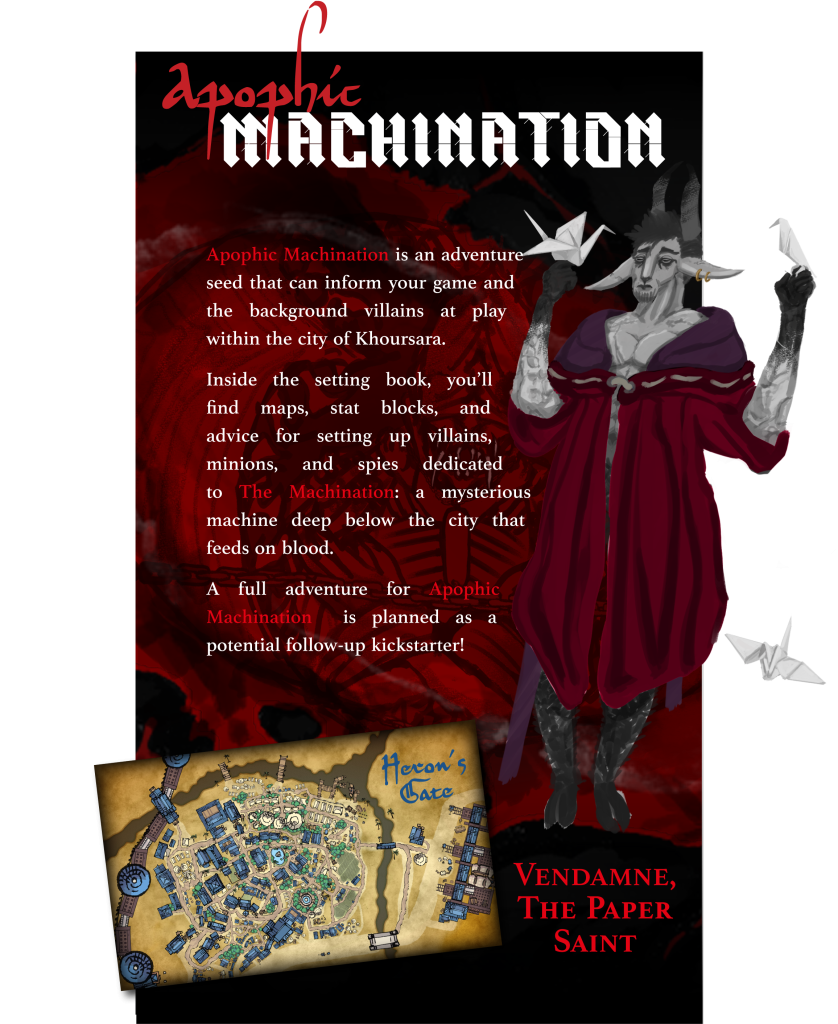
Part of the design thesis was establishing a style guide and laying the groundwork for what the project was aiming for. Another part of my ethos was integrating the thematic component of cycles into the title of the setting itself symbolic of the fused past and present.


You can find the 50-page demo of the later full 200+ page book here, and scan the QR code below or click here to enter your email to be notified for when the full Kickstarter comes out!

When Zagan Falls – A Mythic Bastionland Realm
This Mythic Bastionland setting supplement features a homebrew campaign setting I played with my friends with art history inspiration, as well as games like Dark Souls, Elden Ring, Steve Jackson’s Sorcery! and shows like Record of Lodoss War! I didn’t have much time to put it together in time for the Jam, so it will be an ongoing project. I plan to add more layout, editing, and art too! It was a blast to illustrate, design, and write a module for such an inspiring system! For use with the incredible Mythic Bastionland by Chris McDowall!
For the full thing, take a look at it on itch.io, where I submitted it for a fan content contest.
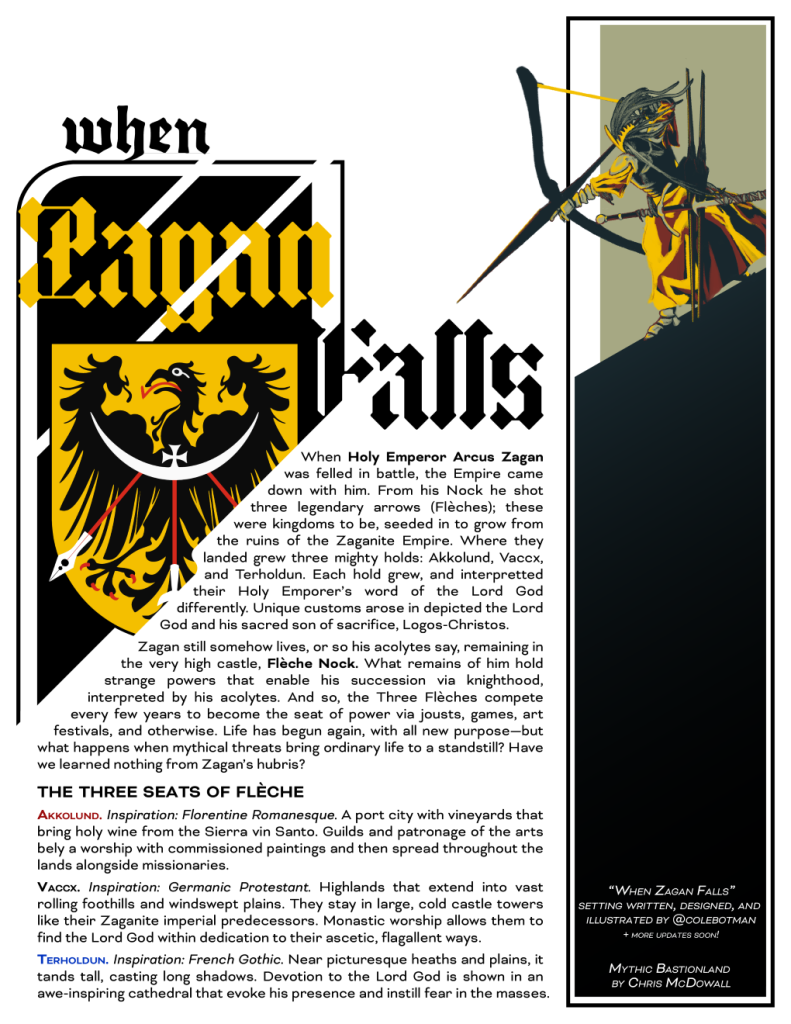
Arcus Zagan II was the Emperor of the Holy Zaganite Empire. When he falls in battle, so too will his kingdom. His last effort as Emperor was to launch three mighty arrows in different directions. Where each Flèche (arrow) landed, a hold blossomed. And so, every few years, one of the three holds – The Three Seats of Flèche – compete to become the Seat of Power, with Zagan’s acolytes relaying their choice from the weakened king up on his mountaintop castle.
The goal is to add more unique mechanics to places you can go, like the treacherous ever-cloudy mountains of Karkanosze, which has unique rolls you make for each fog tile you cross through, or the Fogfen, which you adapt to once you meet a seer. The main content right now is the Realm map (pre-labeled and un-labeled!) the mountains and stronghold of the Emperor Zagan, which includes a site map for his fortress – the Flèche Nock. There are seeds of adventure included, as well as interactions between where some of the landmarks are placed, and the Myths I randomly rolled from the base Mythic Bastionland book and re-written in context to the Realm. Of course, the integration is open-ended enough for you to re-use the map for any myths to see how they interact with the setting itself! This will be an ongoing project that I intend to add more stats/ art / design to / edit and test as time permits.
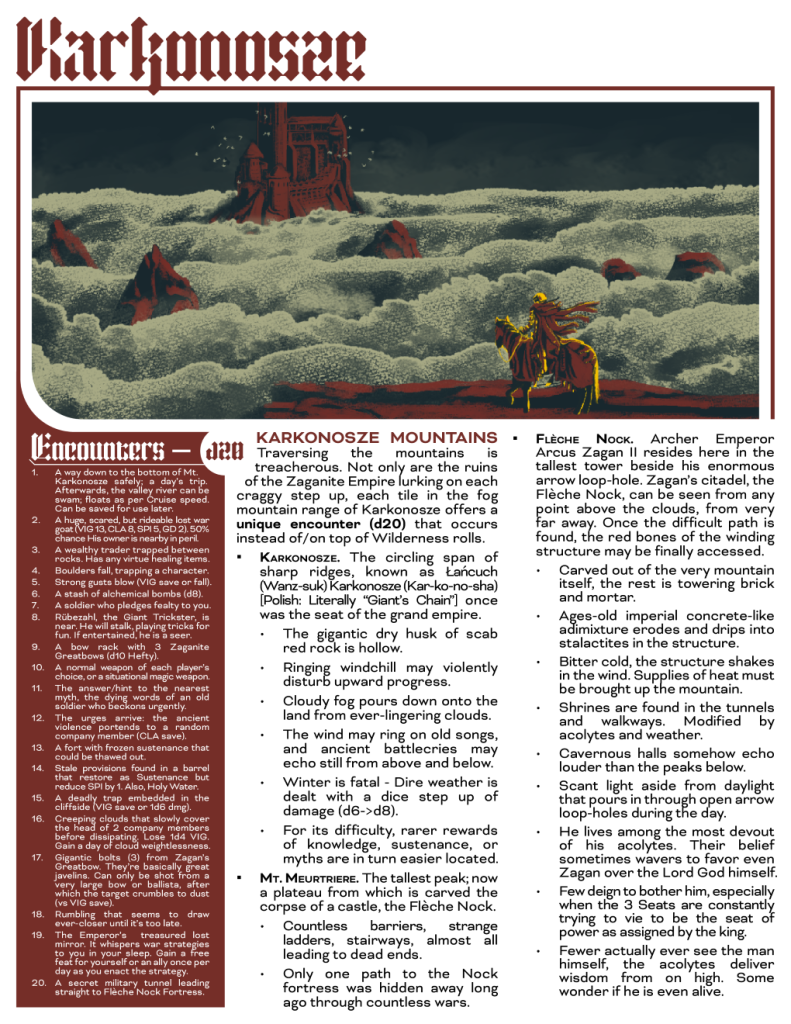
Silt Verses TTRPG Custom Faith Sheet – The Warning Signs
The Silt Verses is a podcast about a world with horrific divine entities that feed on humans, symbolic of capitalism. Likewise, the tabletop-roleplaying game is steeped heavily in commentary about corporate machinations that turn normal workers into cogs within a greater machine, all with the purpose of gaining sacrifices. In the game, classes are instead defined by “Faiths,” each providing a Custodian (player) a glimpse into what worshipping one of these corporate (or illegal) gods can bring.
For my own homebrewed Faith sheet design, I decided to riff on iconic OSHA safety symbols, working with my Warden (GM) Toby Tegrotenhuis, to write a setting-appropriate introduction to the Faith. In the end, I helped game design and write the core “moves” (class features), and put the whole thing into an employee-official looking booklet (instead of a typical TTRPG sheet) that looks just like we imagined it would in-universe.
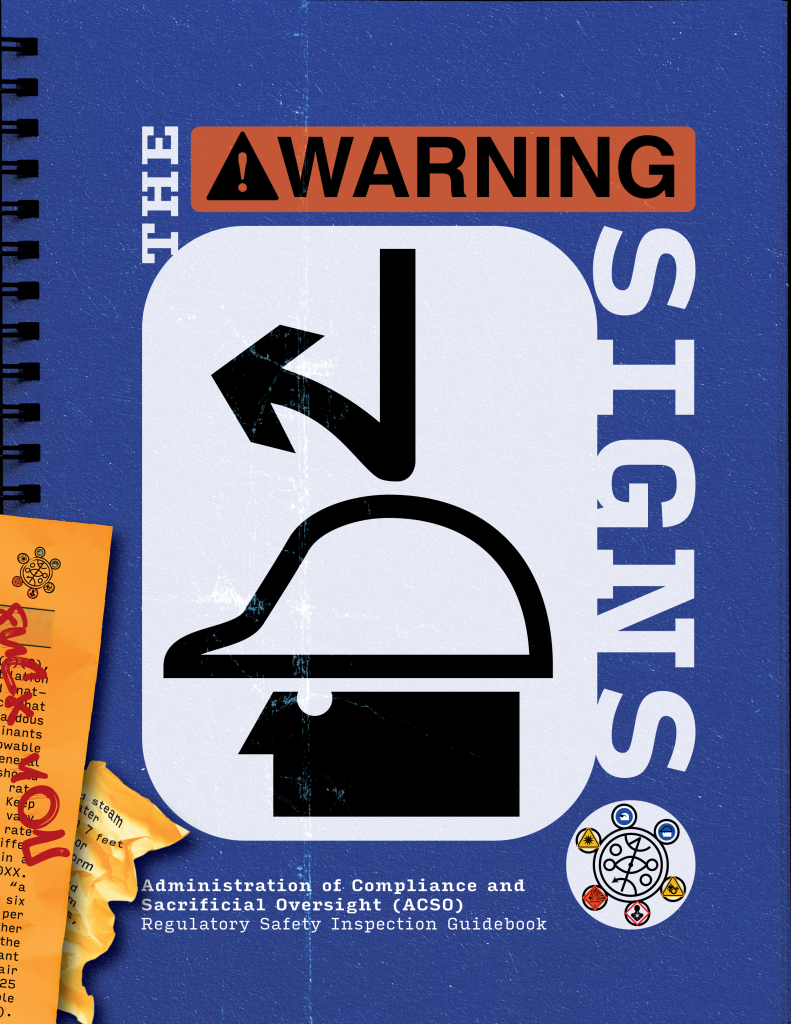
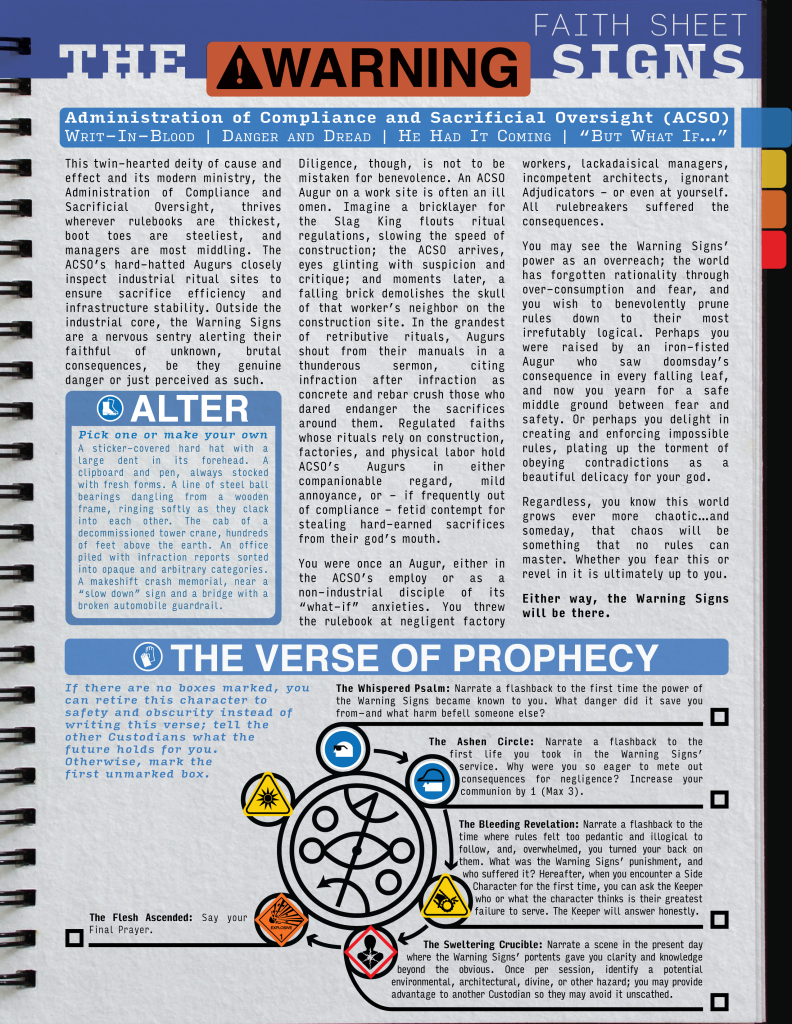
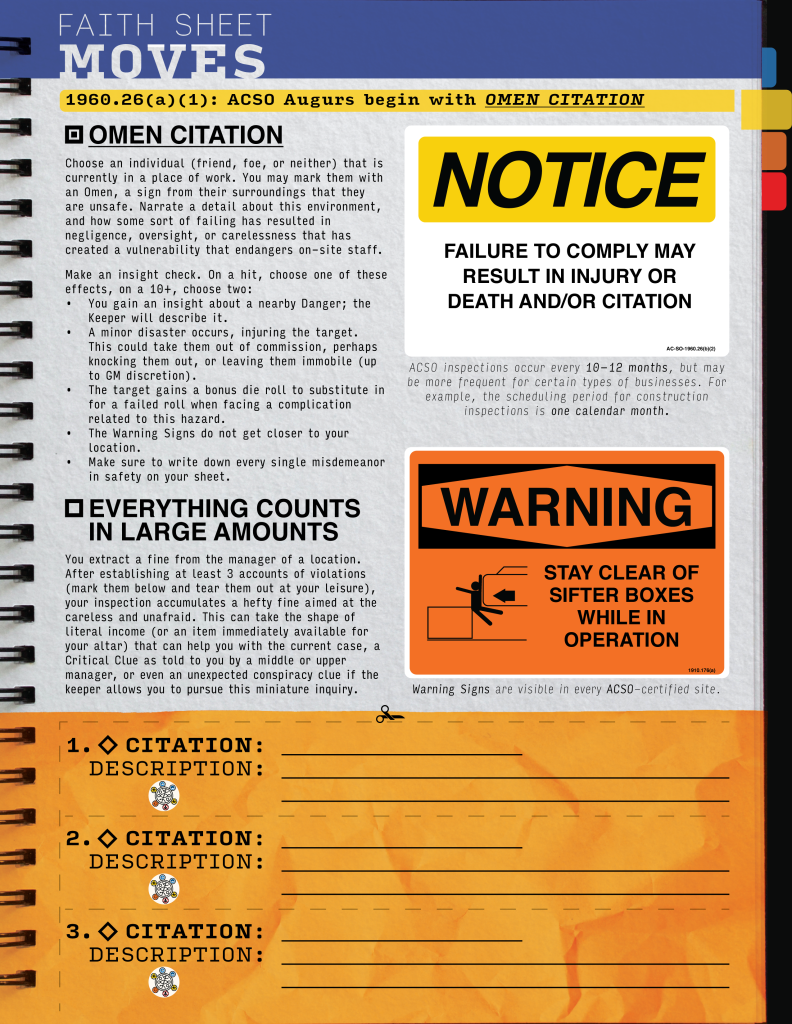
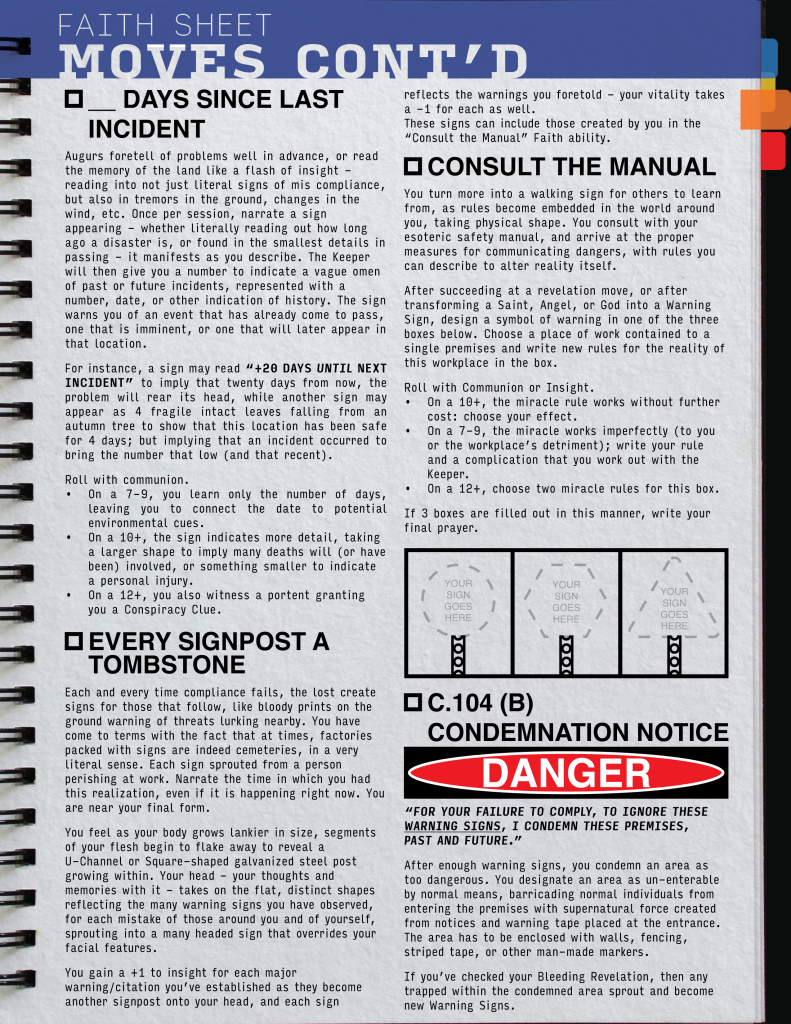
D&D World Setting: Infinis Ajer
I’m a particular fan of Wizards of the Coast’s Dungeons & Dragons, but more particularly the design philosophy of Paizo’s Pathfinder 2nd Edition. After years of playing this table-top role-playing game with friends, I figured it was time to write and design my own content.

I decided to write my own world setting for the game on a gigantic scale. The core premise of the world of Infinis Ajer is that it is fueled particularly by human faith. What human cultures believe is in turn made reality. Thus, societal concepts, like gods, religions, or the imagined way the world should work all rapidly change at the hands of humanity’s collective belief in their surroundings. It’s an idea I thought of while exploring art history and the vivid worlds imagined by completely different cultures for the same concepts.
Another result of this faith is that Infinis Ajer has restarted itself over completely from memory hundreds of times each time this faith reaches a boiling point and creates problems – such as The Seraph of Cinder – unbound by Gods and controlled fully by people. This Seraph nearly ends the world each generation, but is instead slain in a particular way, sparing life as we know it and instead burning away the collective memory of the entire world. While the physical artifacts and ruins of previous societies still exist, the ancestries of the world forget everything and start over from the stone age, gradually building layer after layer over previous cities, adapting their technology, customs, and culture as their own.
D&D Adventure – The Ladice Mastaba
The Ladice Mastaba was an adventure I designed for my game that I wanted to fully produce, complete with custom game design in encounters, boss mechanics, and floor layouts for each level of this dungeon.
The background of this dungeon involves a Khoursaran Noble, Fielence Ladice, who was previously head of the royal treasury of the Pharaoh. Fielence was interred after a coup left half of the seven Nobles of Khoursara dead. Inspired by the tombs of Egyptian nobility from the real world, I wanted to represent his tyrannical, childlike nature in the dungeon itself. His life was spent with everything served to him on a silver platter, and as a result he takes literally everything for granted and never wishes to deal with the adult responsibilities placed on him with being a treasurer. Each room is hand-crafted to reflect the world Fielence intended to bring with him into the afterlife – ranging from childhood parties filled with mummified remains of his relatives, an entire boat in reference to the real-world Khufu ship, an undead pet orca, and much more.
Encounters included meeting Fielence’s equally unpleasant parents as mummies, a snake-priestess who paints mythology upon the walls, Shadow Fetchling Operatives to compete against the player party in locating Fielence himself, disguised torch-traps, and a massive gelatinous cube made of embalming fluid intended to clean up and prepare bodies for mummification within the crypt.
Other parts of the design included a “God-Blind,” which was something I came up with in my setting to explain the reason as to why such a lair of undead could exist without the pantheon Gods of Khoursara intervening against it. In this God-Blind in the center, magic and connections to faith fizzle out as lead, specially-treated bronze, and sand constantly pour into a pit below, nullifying arcane and divine connections. It also means powerful artifacts can be concealed below without divination magic locating it.
The center of the dungeon had this God-Blind, and disabling it would not only allow access to the deeper regions and even Fielence himself, but also alert the rest of the world to its opening. The idea was to give the players a difficult choice as to whether or not they should continue through the intended way or find another way below.
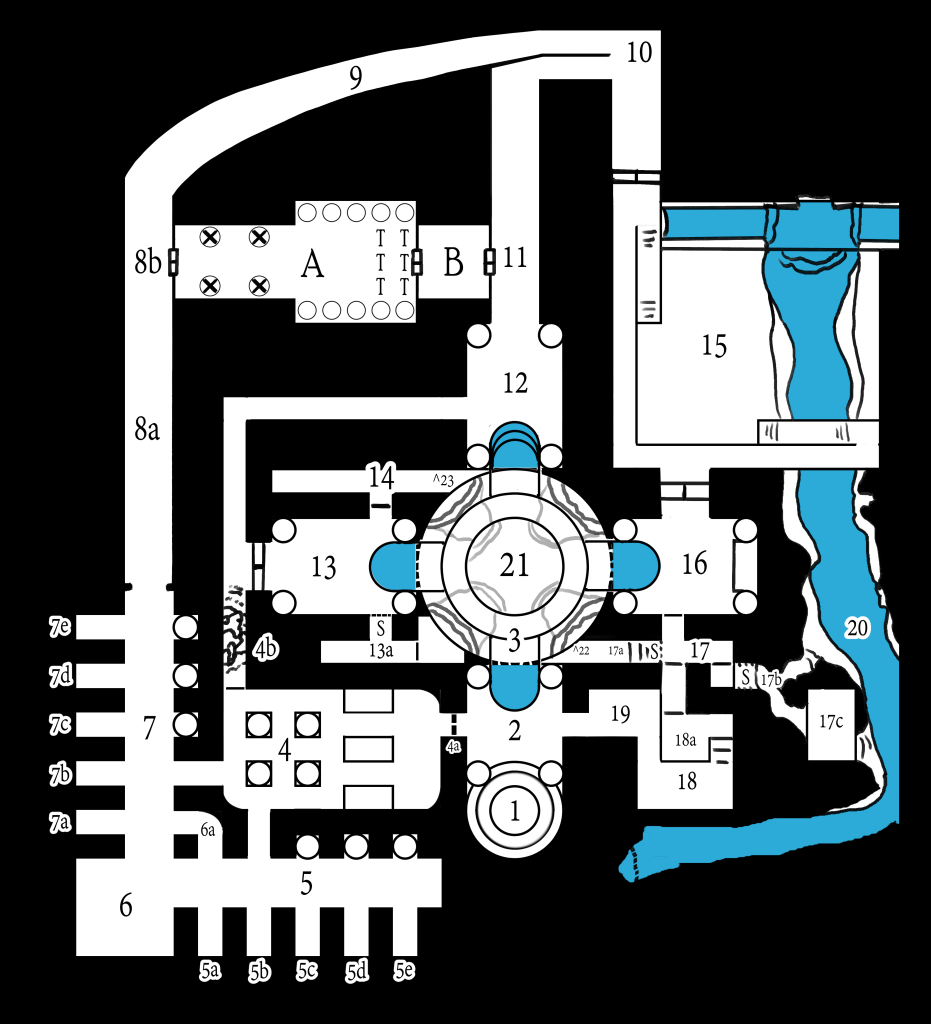
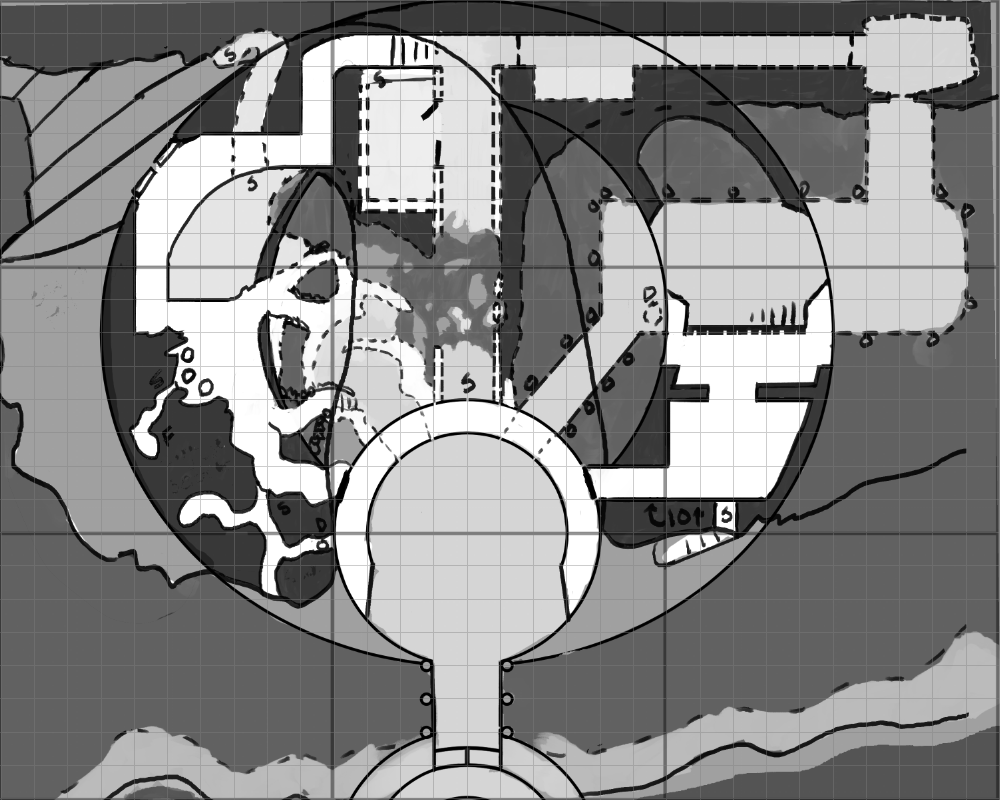
Photography – Miniature Models
For a introductory photo class, I figured what better subject than my partner and I’s painted 3D printed miniatures. To establish environments, I made some extra terrain and lighting conditions to really create ambience to go with the miniature characters, photo’d with a macro lens. The first is of a shadow dragon, the second of a pit fiend, the third of Festrond the half-dead norse-inspired necromancer from a game I ran, the fourth of some mushroom men, and the last was an animated stop motion gif using different models as frames for a mimic attack.
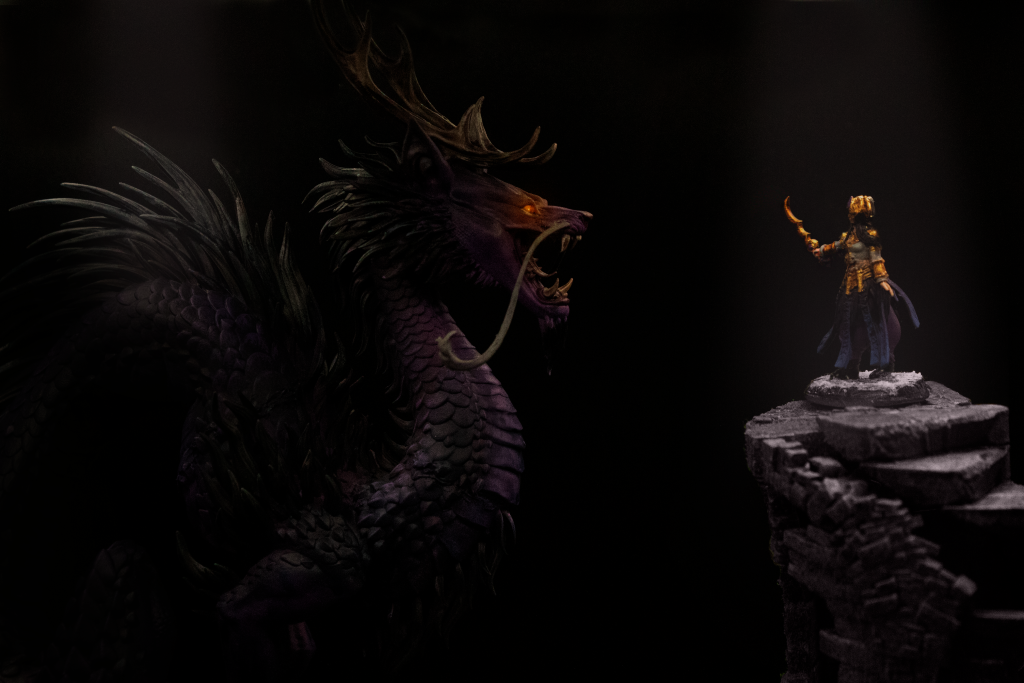
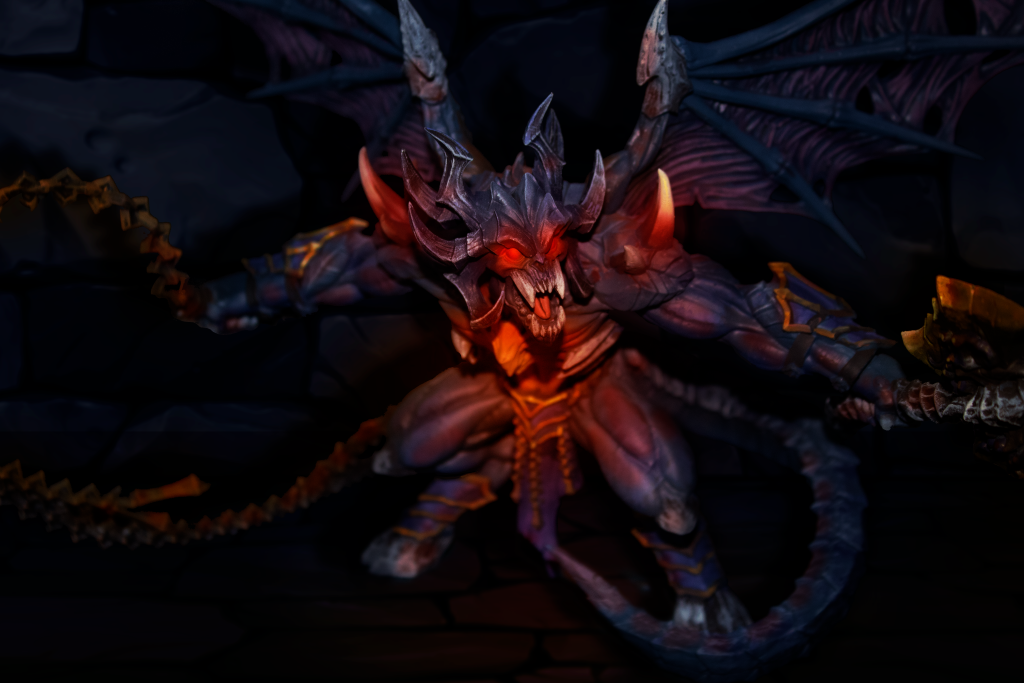
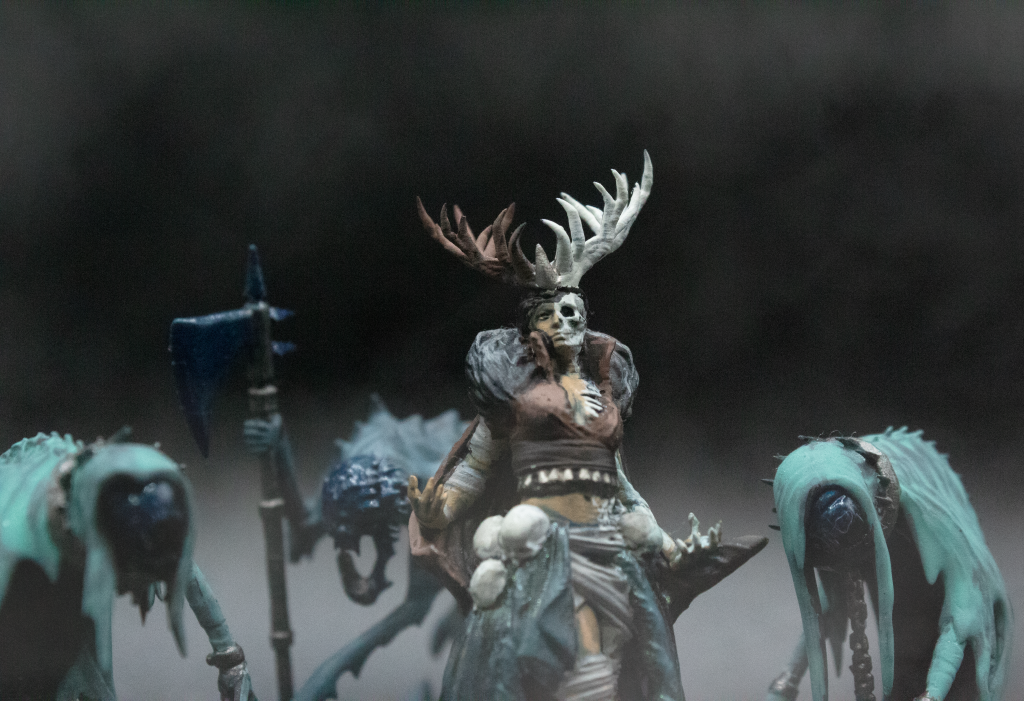
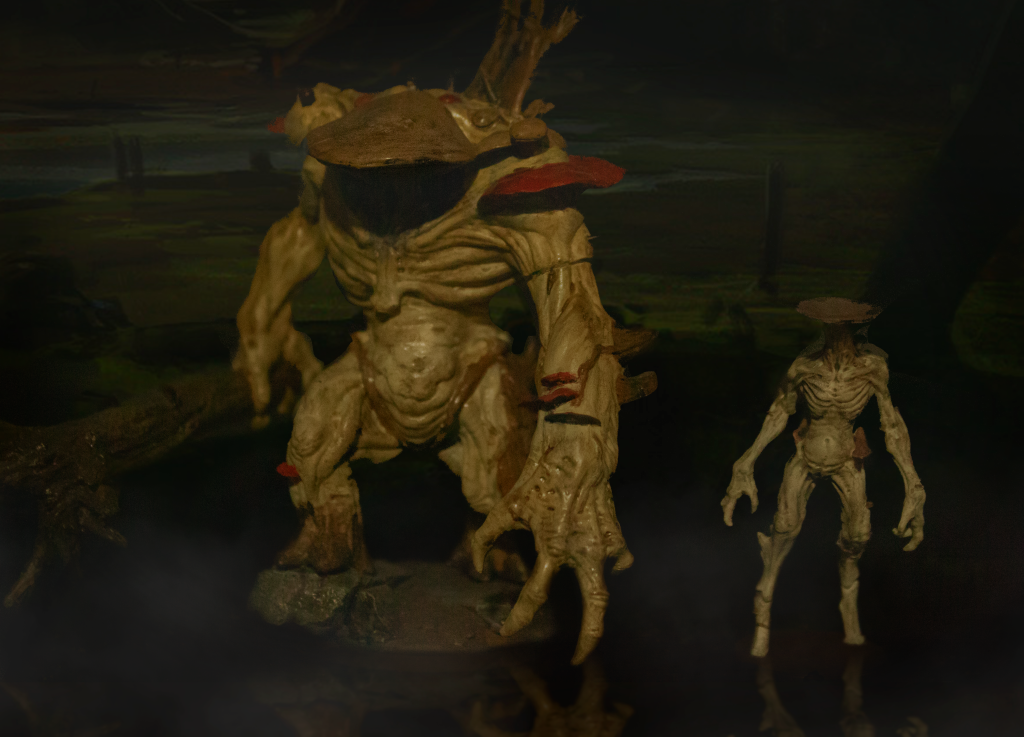
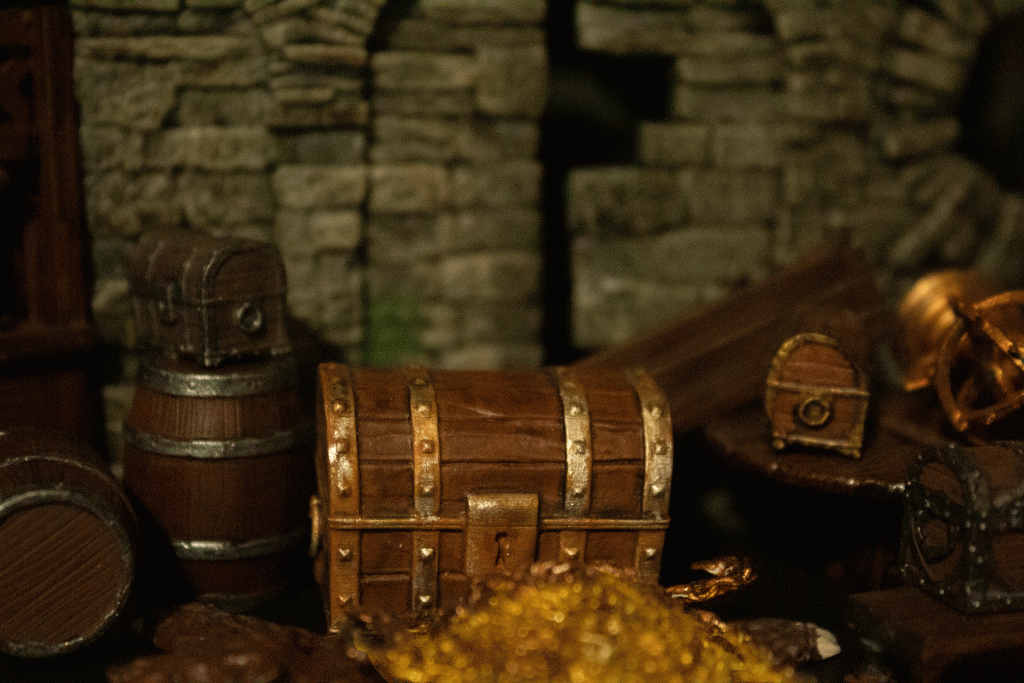
Battle Map Illustration – Orchid Court Cathedral
The Orchid Court Cathedral was part of a quest my players went on in Khoursara. The idea I had was that a gothic-style church was built by missionaries from afar, but their worship was overwhelmed when surrounded by Khoursaran faith in their animal-headed pantheon. I wanted to create the floorplan and layout in a more official, fully-designed way, so I ended up drawing the entire thing. I designed each floor to fit the same square of battle-map, so that it could be printed or overlaid if played digitally.
The church itself was dedicated to followers of a fey god, Zig-Zargon. Without fully realizing it, they brought a corrupted version of their belief into reality, resulting in the church being overrun with infected priests and bishops. The form of the spread manifested as overgrown oleander flowers spreading into the wounds, with an intended encounter of fighting an avatar of Zig-Zargon in the basement; his phylactery in the fifth floor of the church tower. I wanted to convey these themes in the layout of the church, and have written extensively on the design of the multi-floored encounters.
Part of the design is to show height via illustrations of the lower layers being faded as you go higher above them.
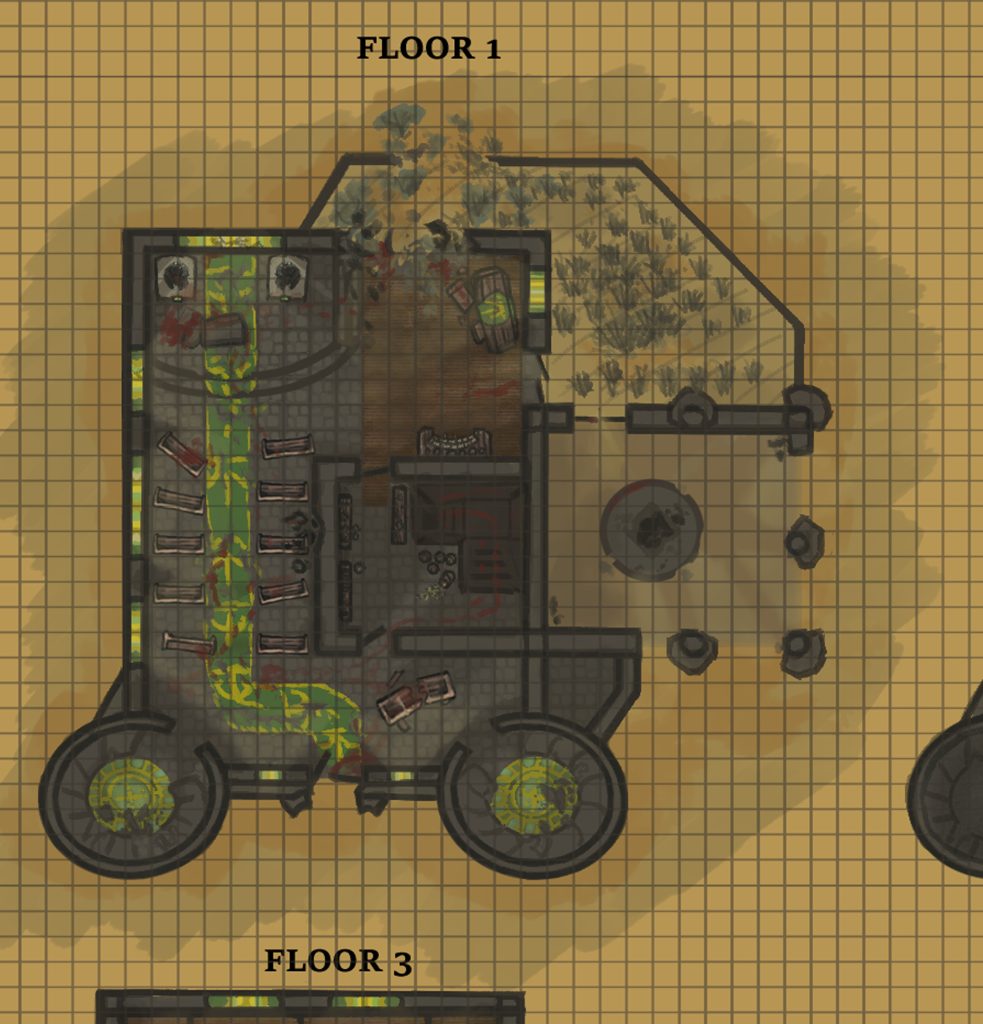
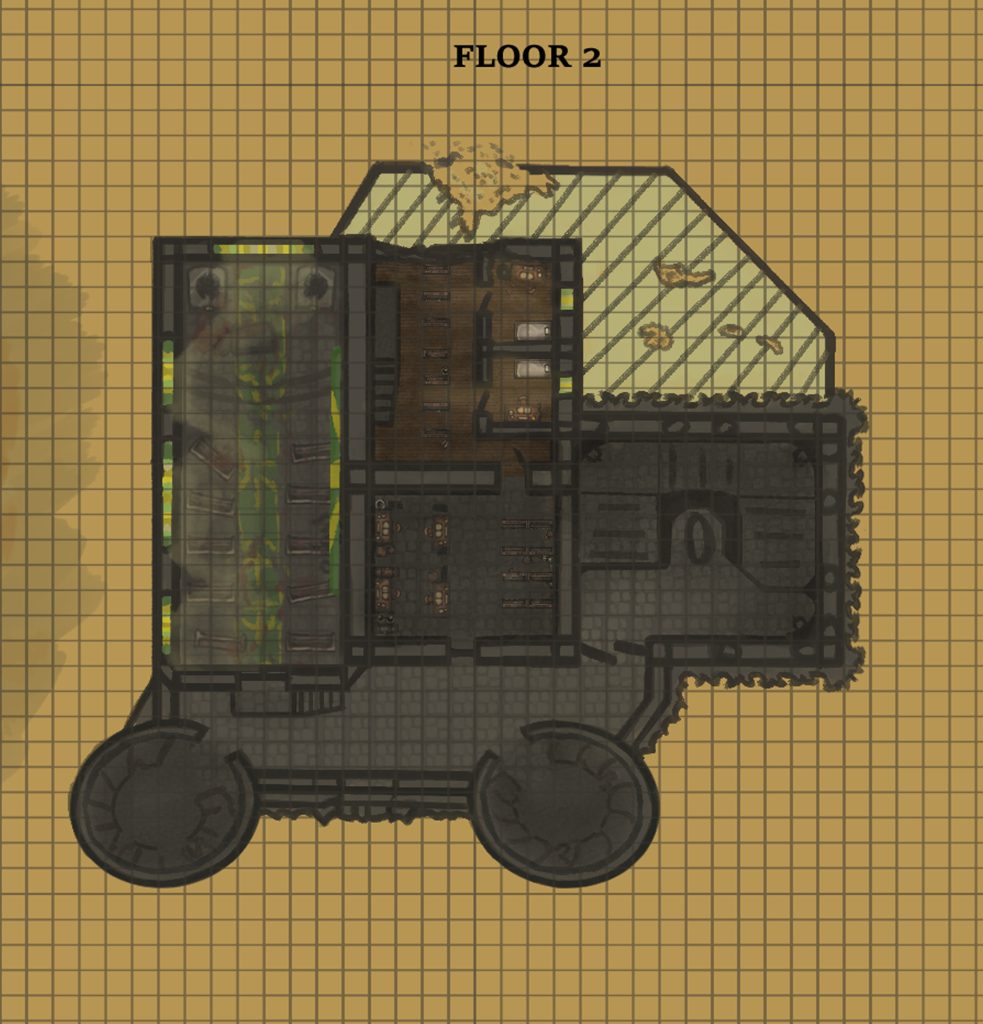
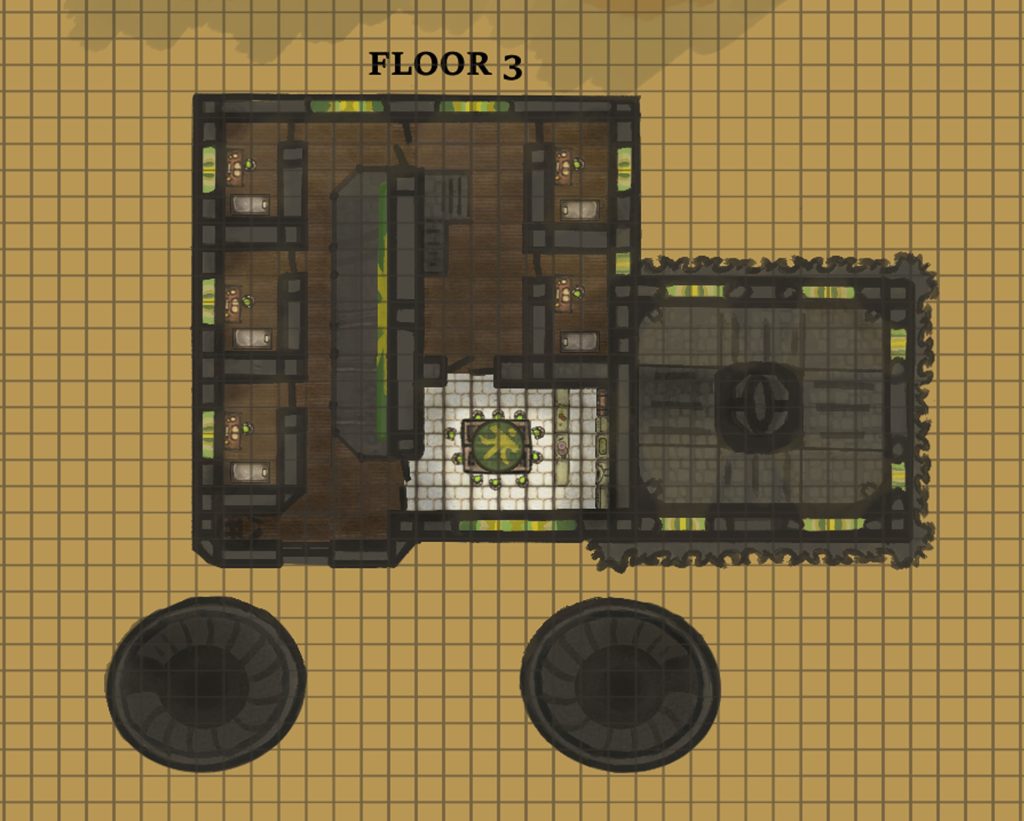
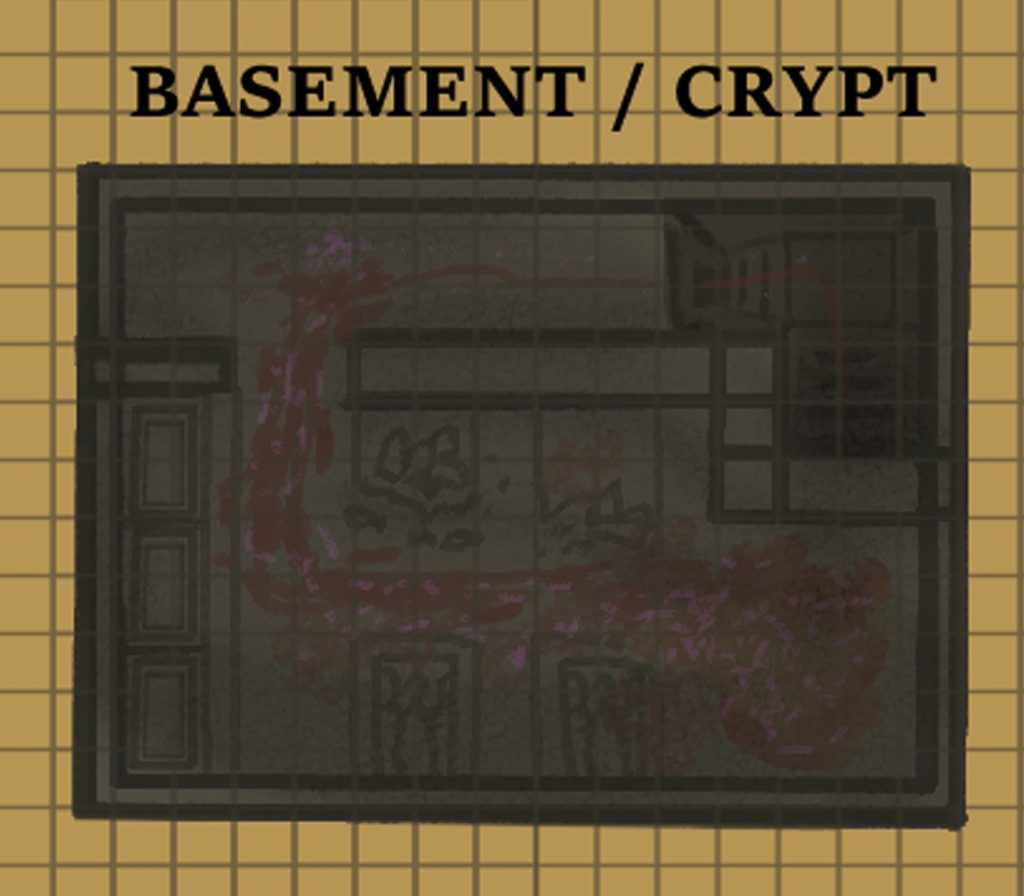
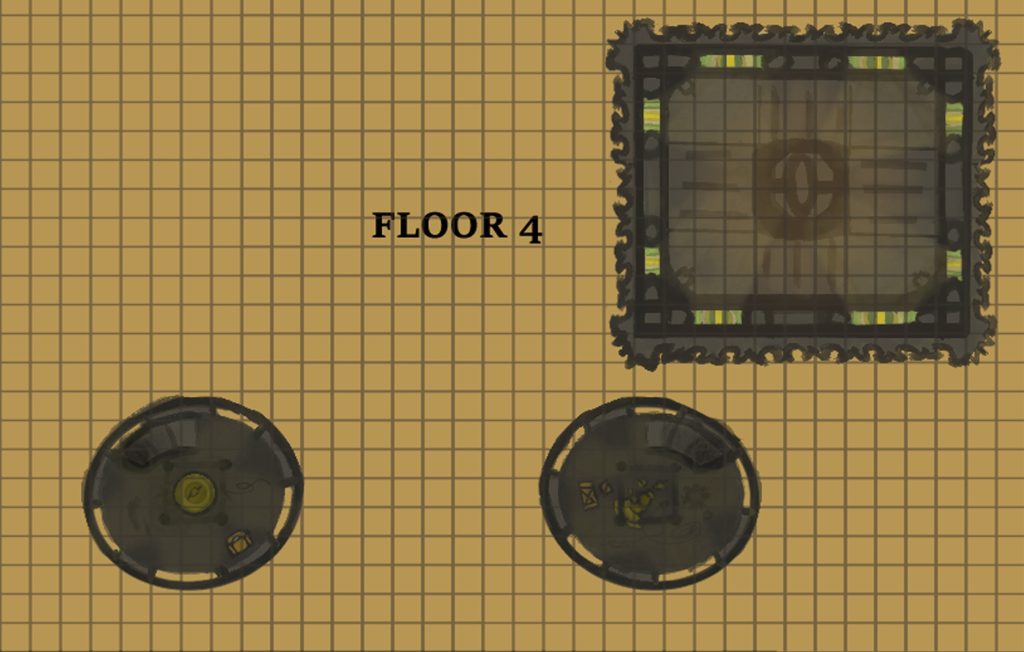
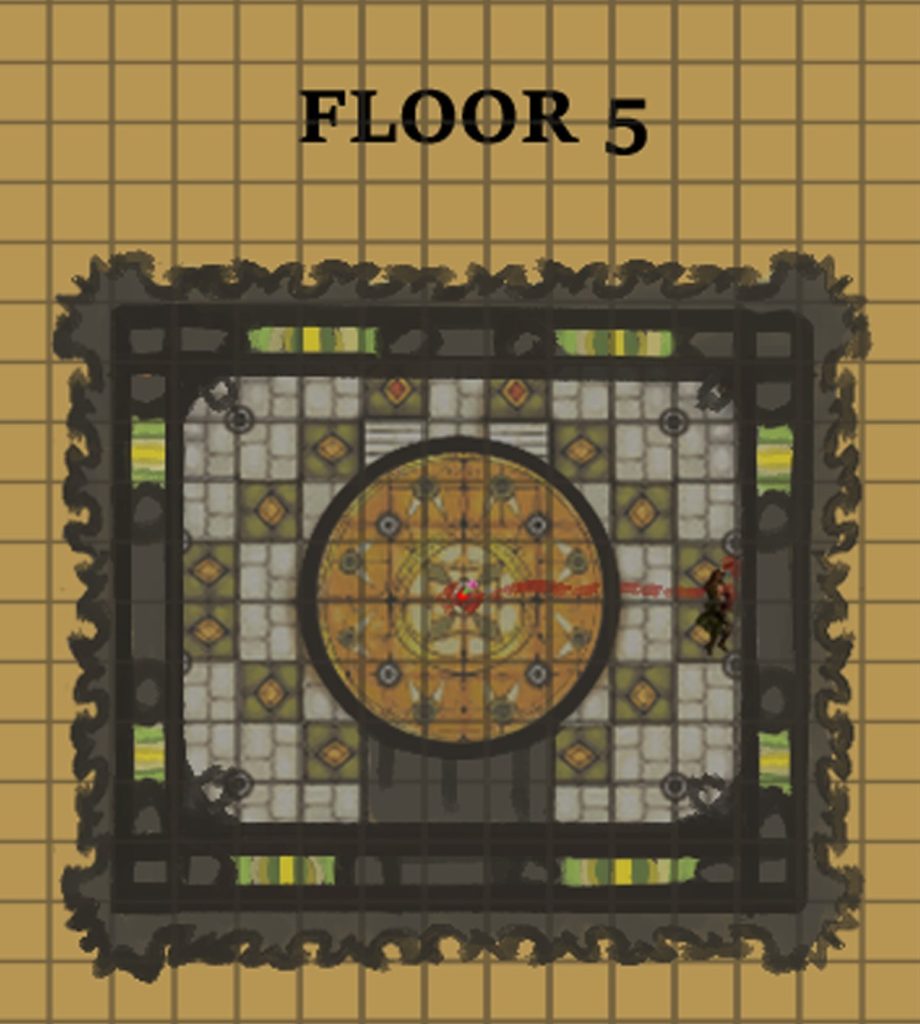
Another project within my D&D setting and in Khoursara, “MIDRA,” saw my first foray into 3D animation. Wanting to continue on my writing specifically into Khoursara further, I decided to recreate a setting with some fog, megalithic structures, and a bit of eldritch horror suspended in the ancient technology. I was inspired by Kid A by Radiohead, and more specifically the song from that album, Everything in Its Right Place. That song gave me the direction to tackle the vastness of the Sentinels surrounding the city of Khoursara, and what lie within their unfathomably huge spires.
Another Part of Infinis Ajer – Journskull
In a different part of the setting of Infinis Ajer, I wanted to focus on the continent of Journskull. This place is 80% jungle, and filled with its own cultural powerhouses. The Phyuzan empire, for instance, draws from Incan mythology in a vast mountain range where gigantic ancient airships are buried. The dwarven cloud culture sprung up for both that reason and for their admiration of cloud dragons.
